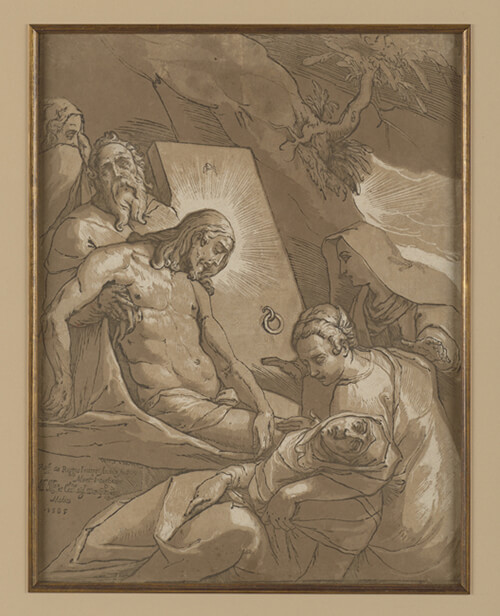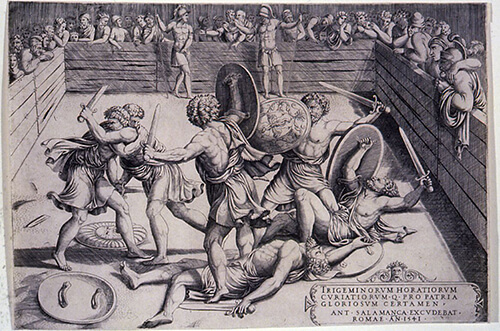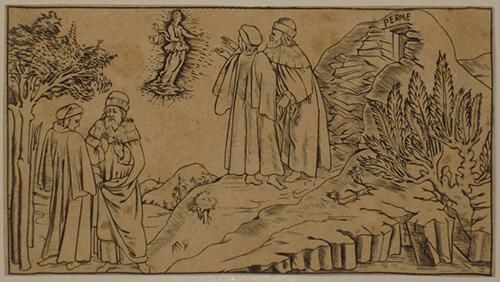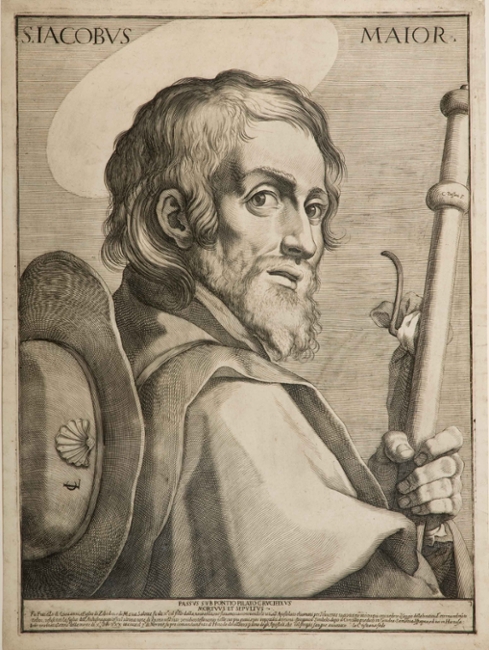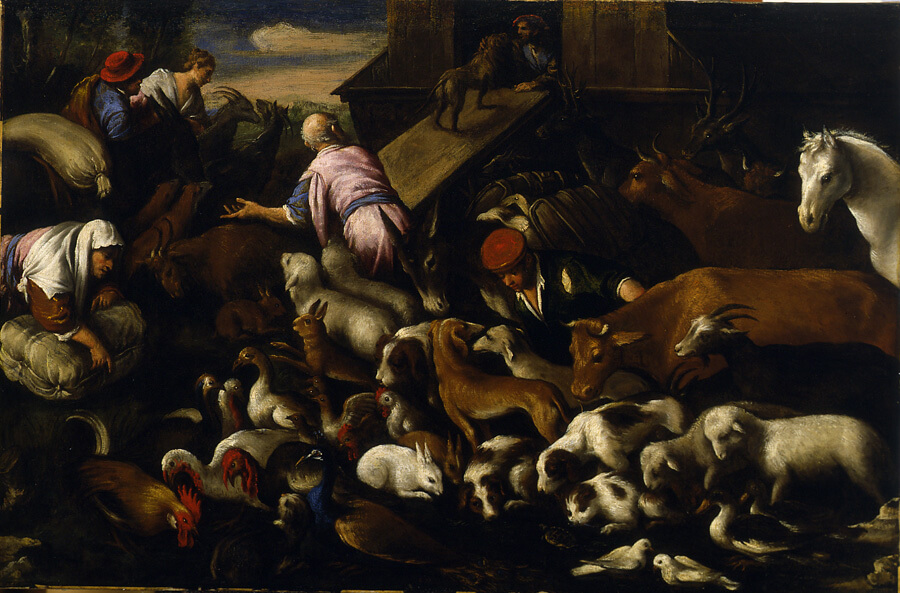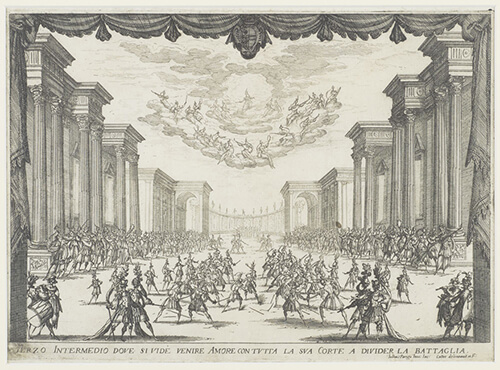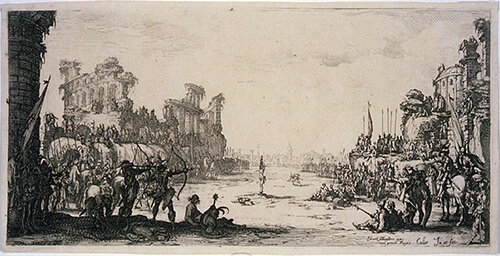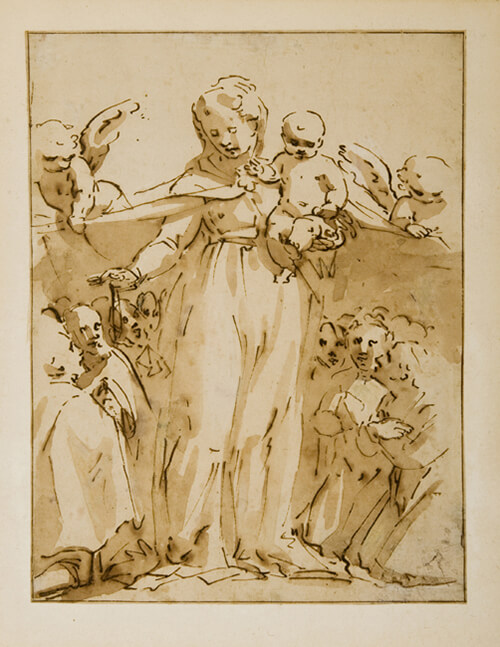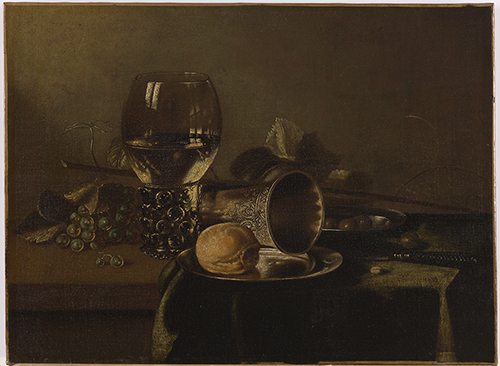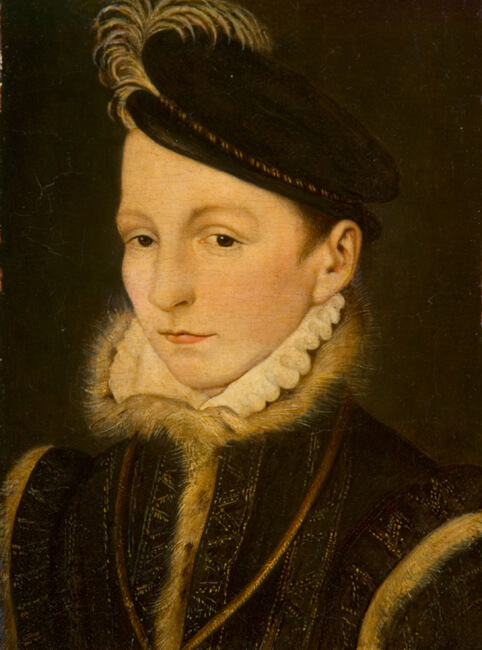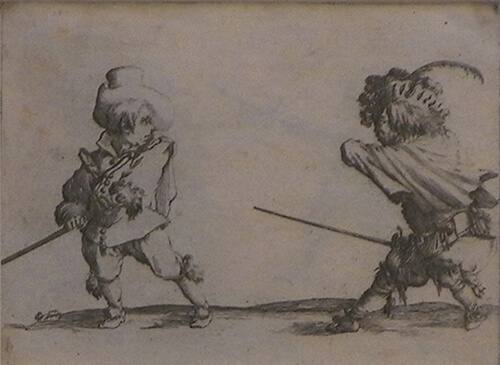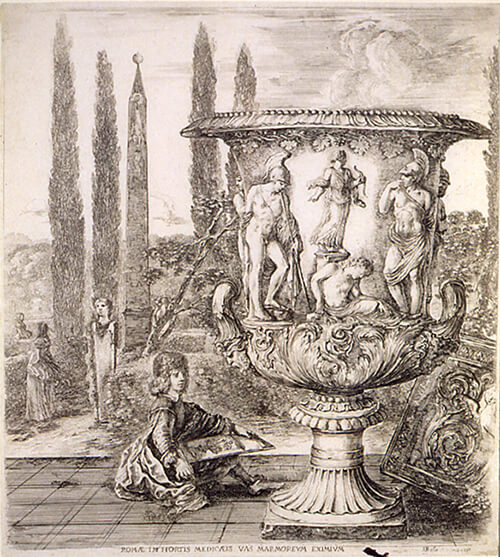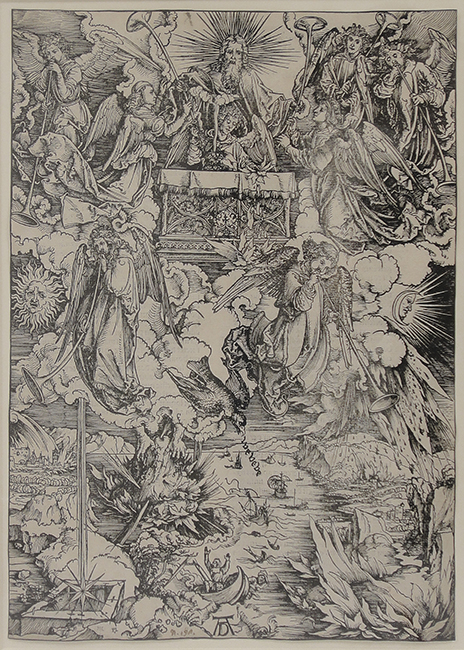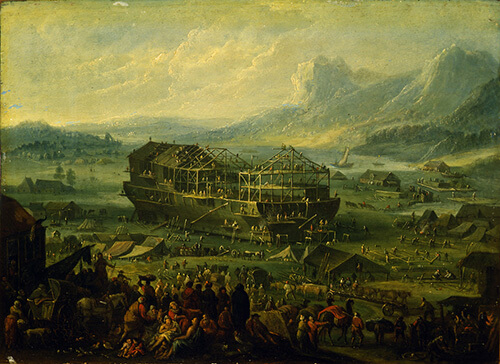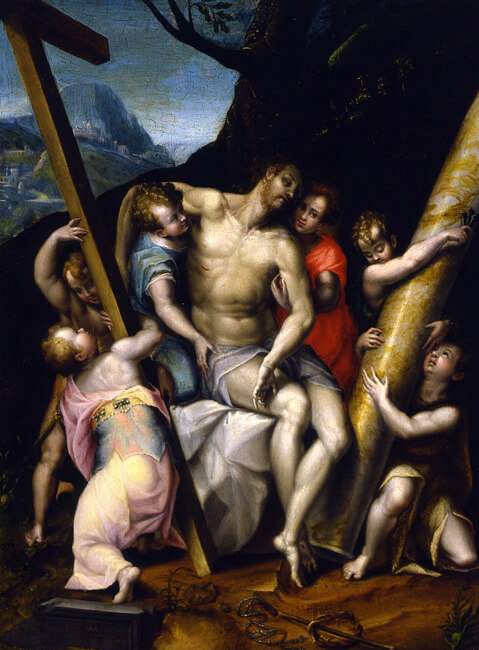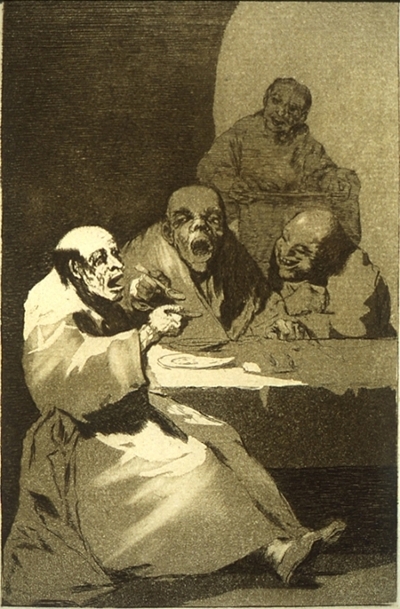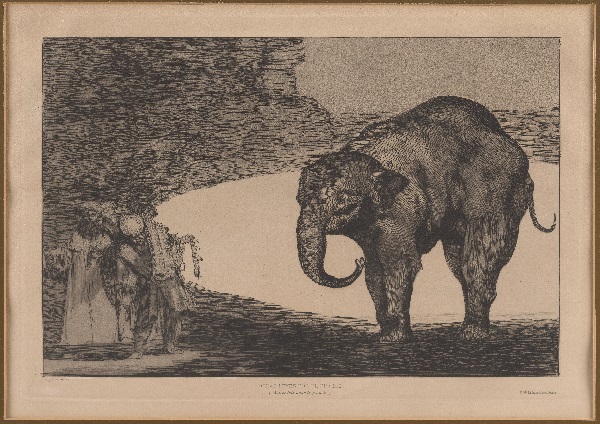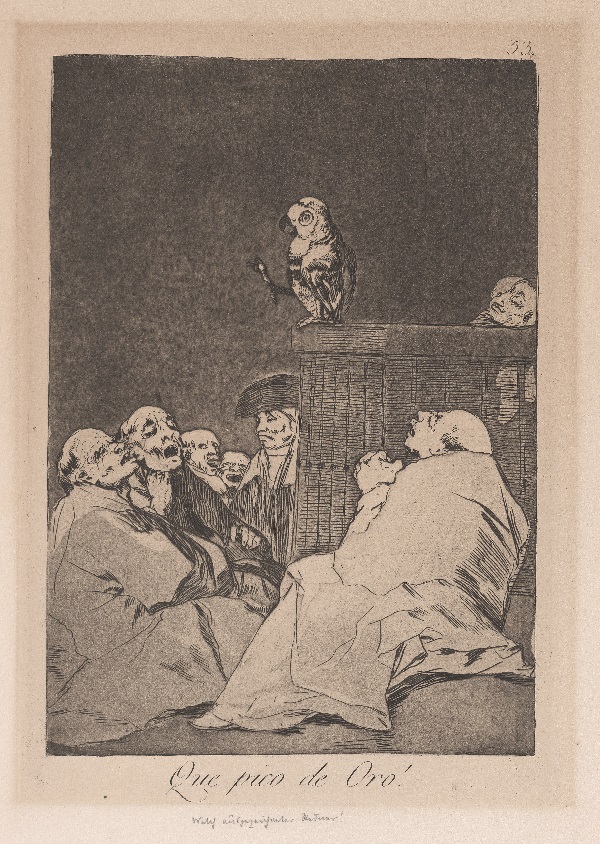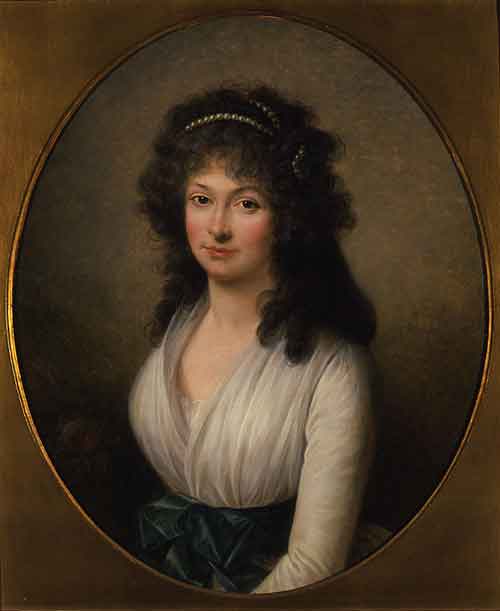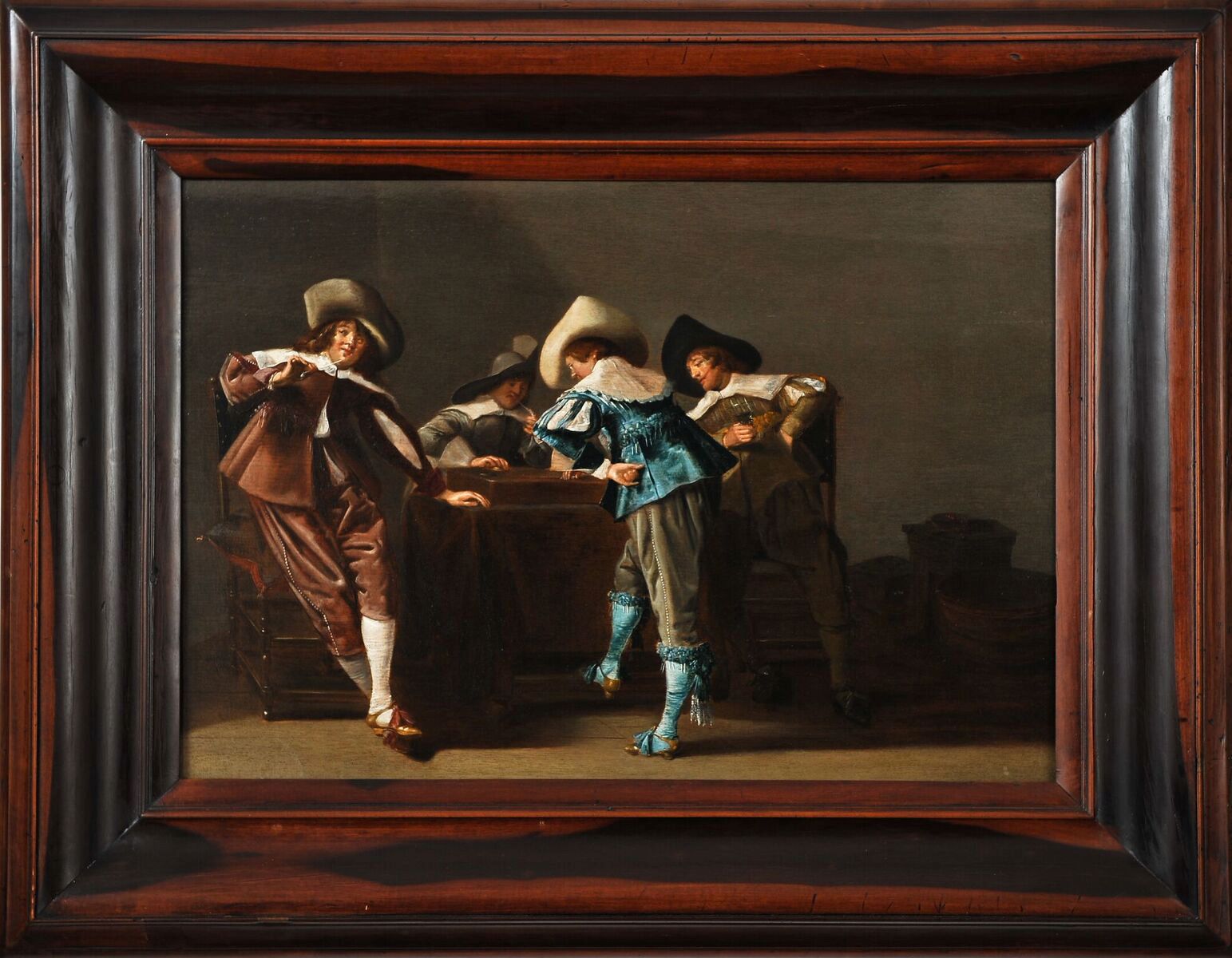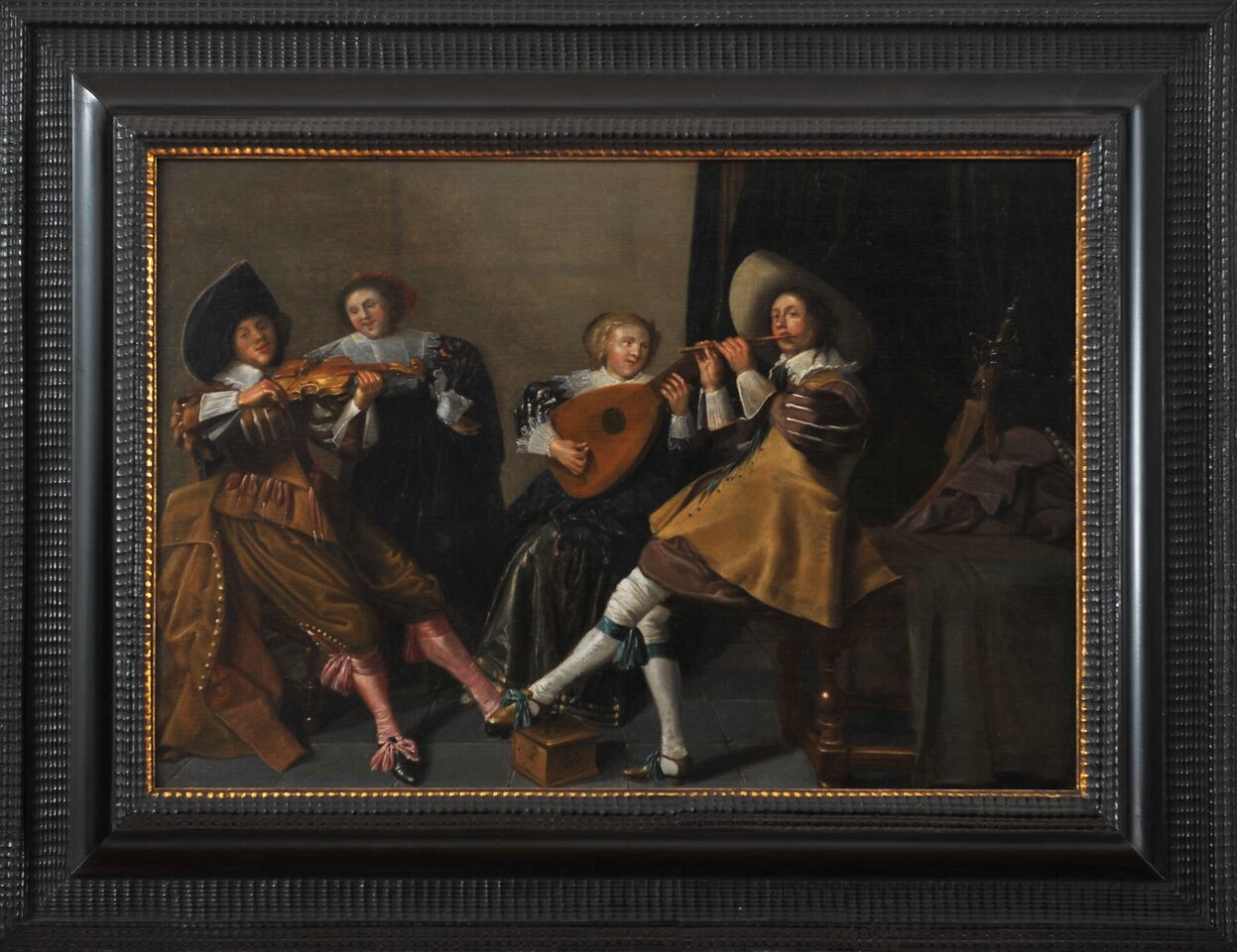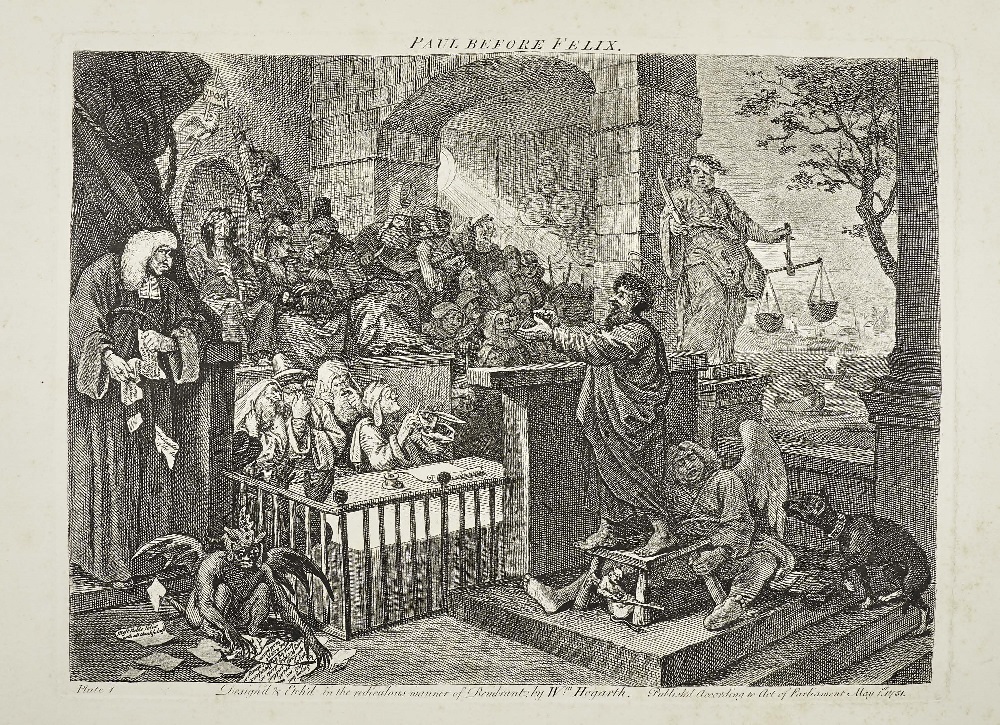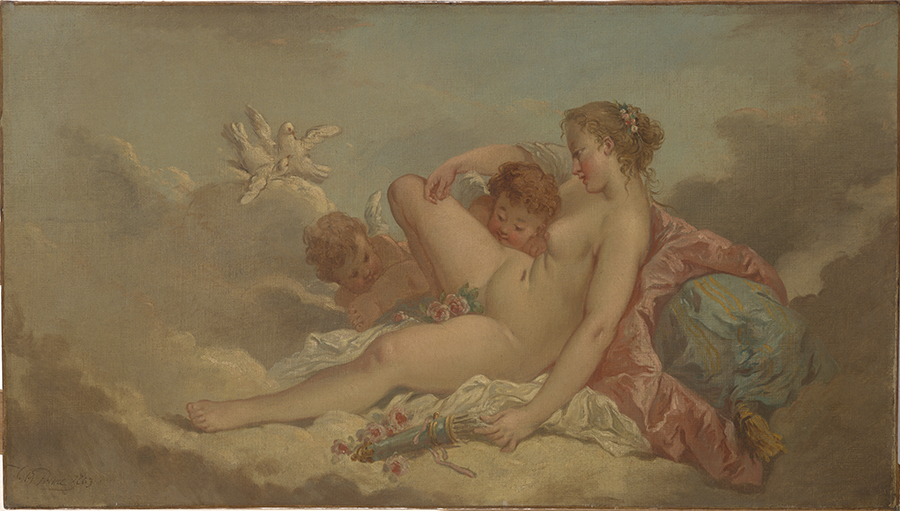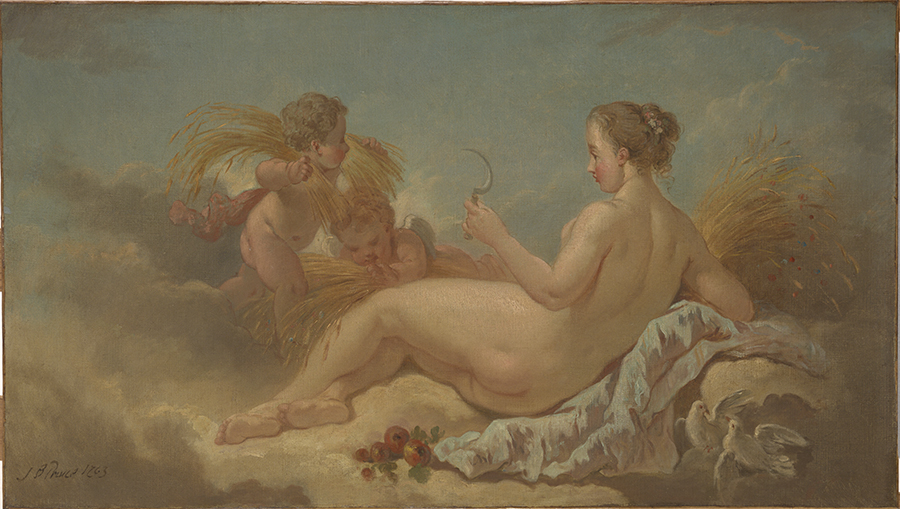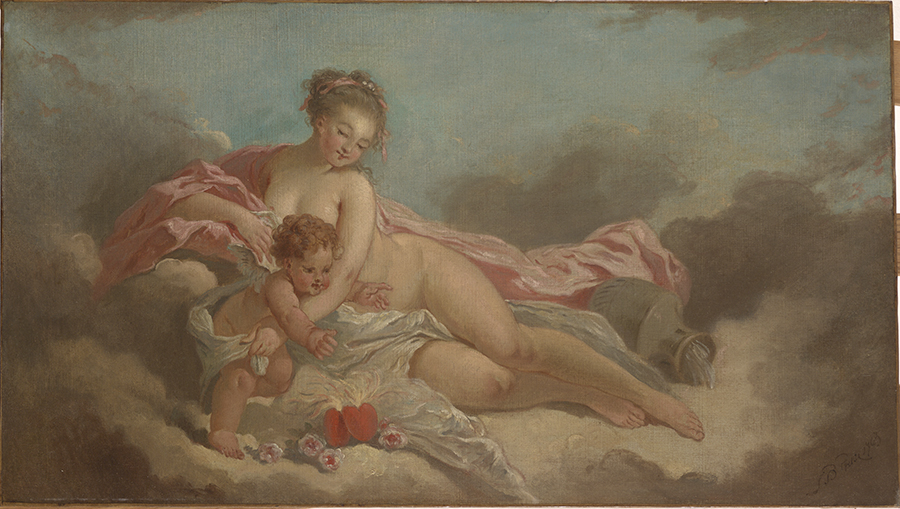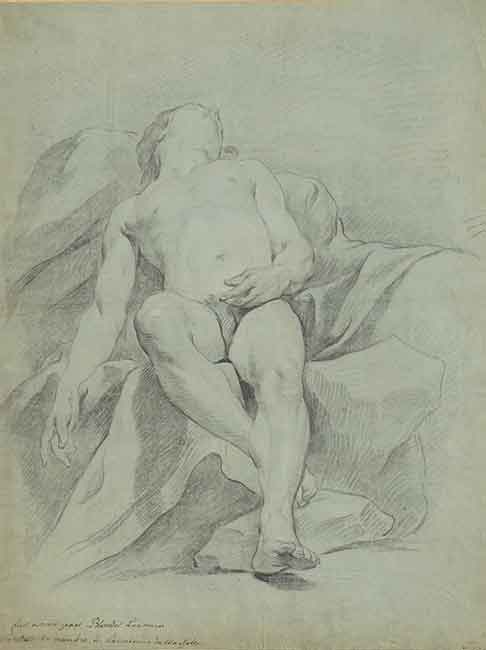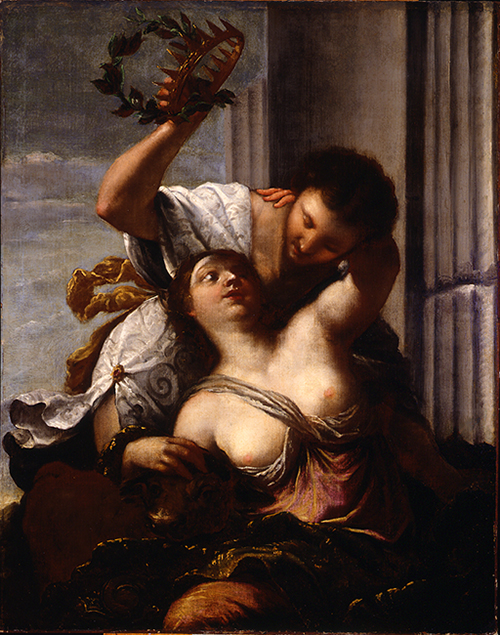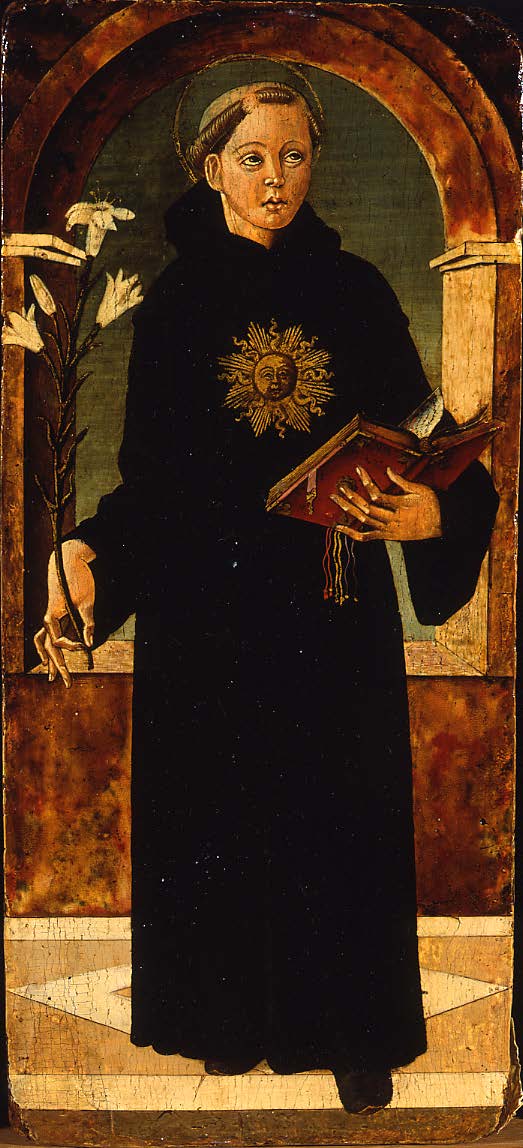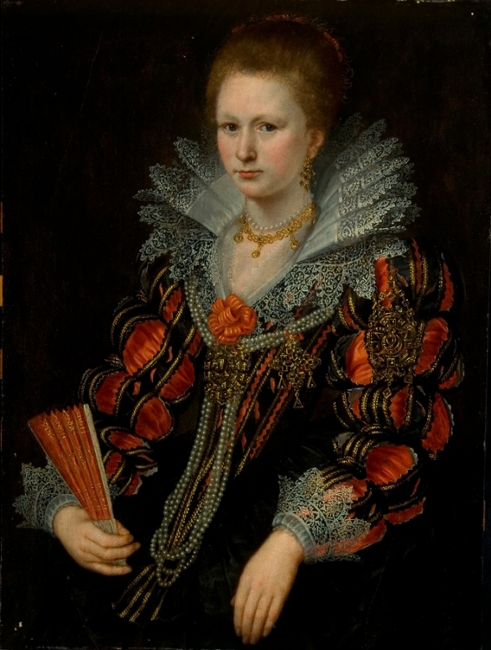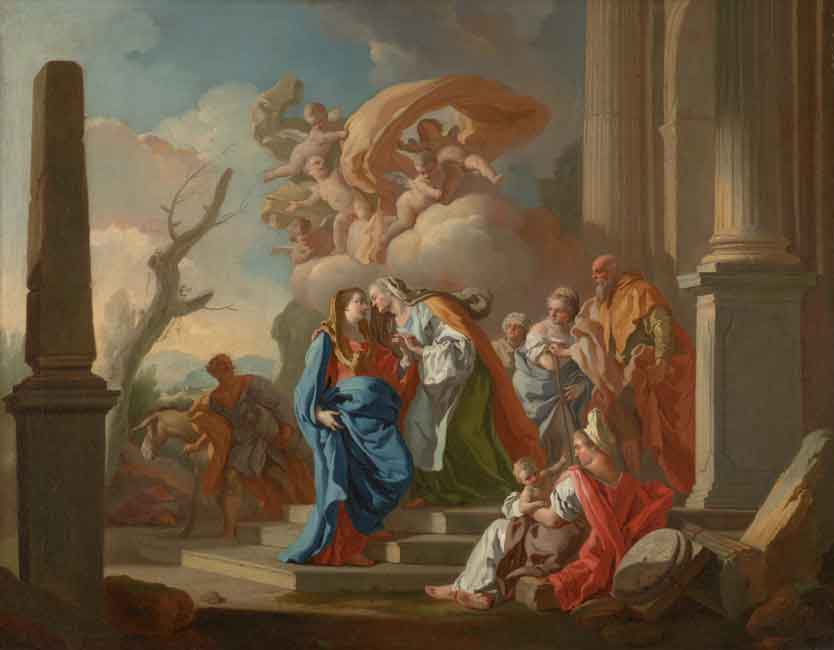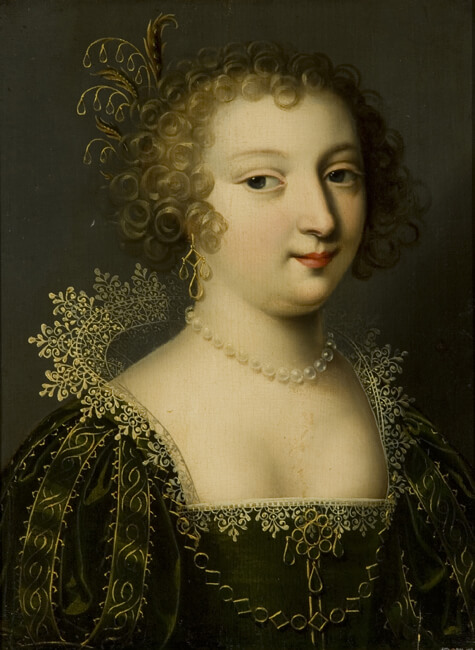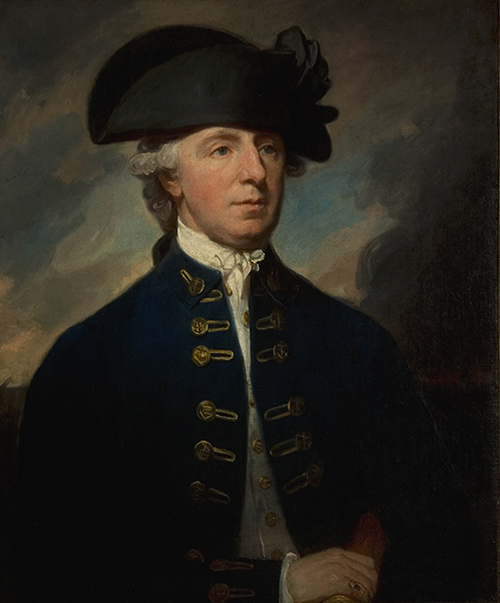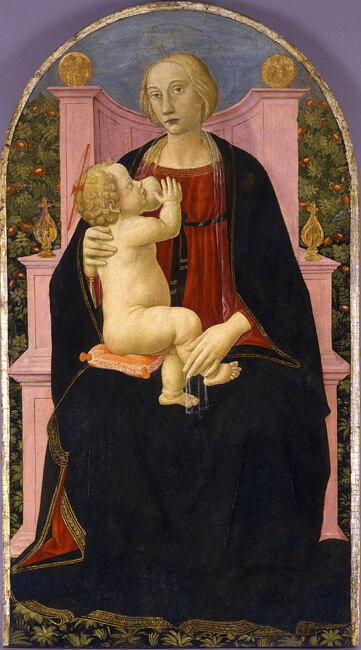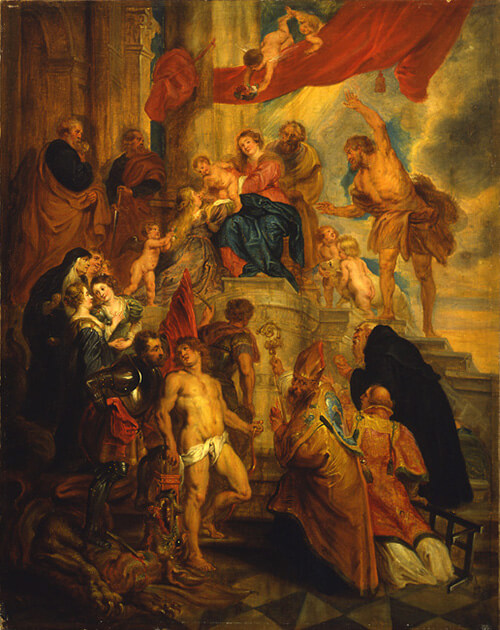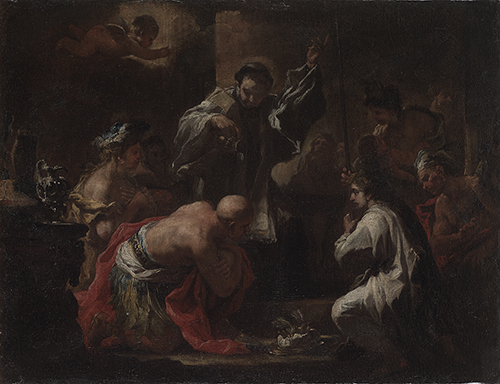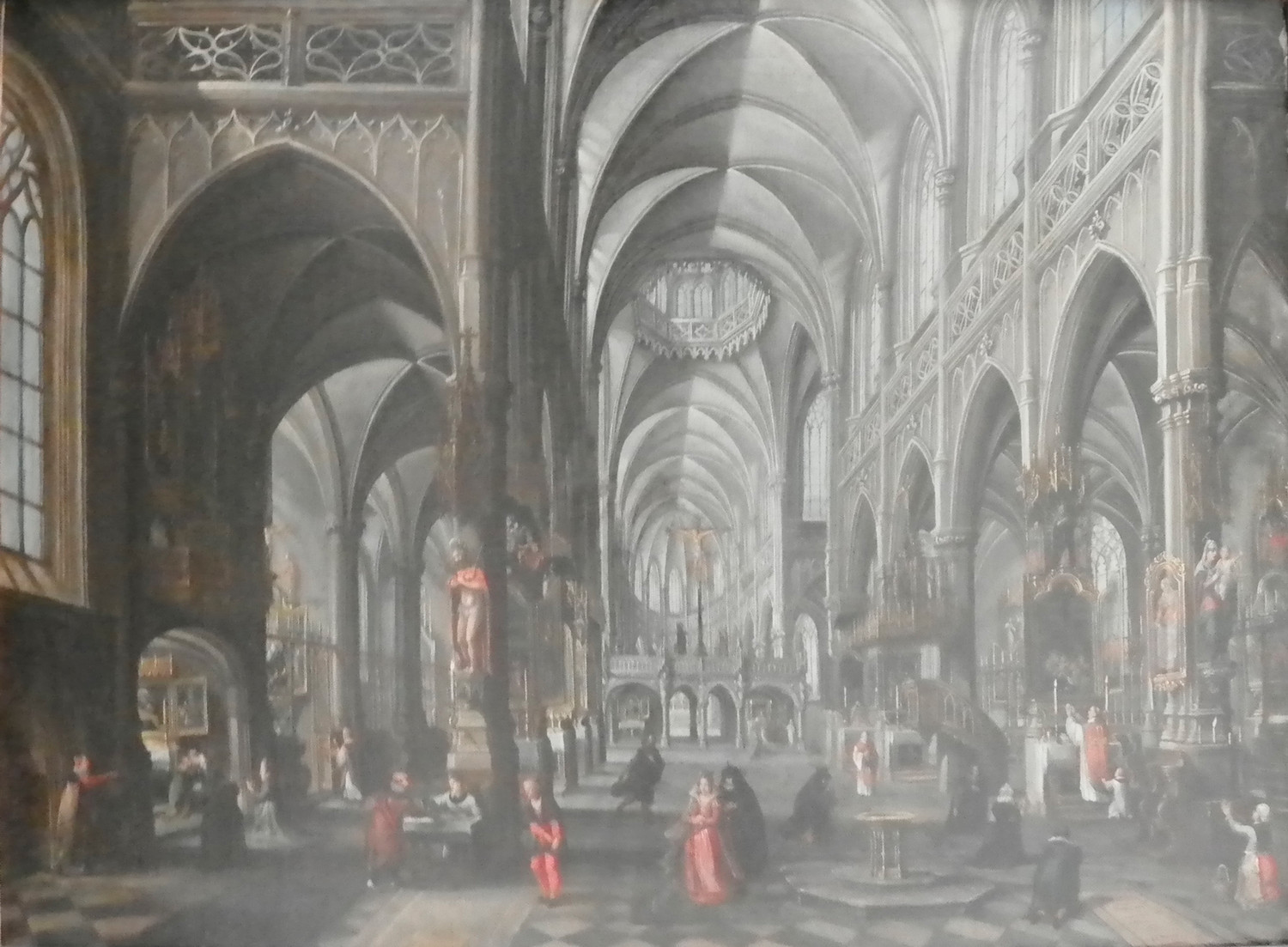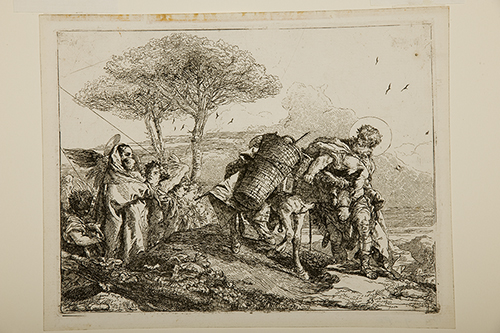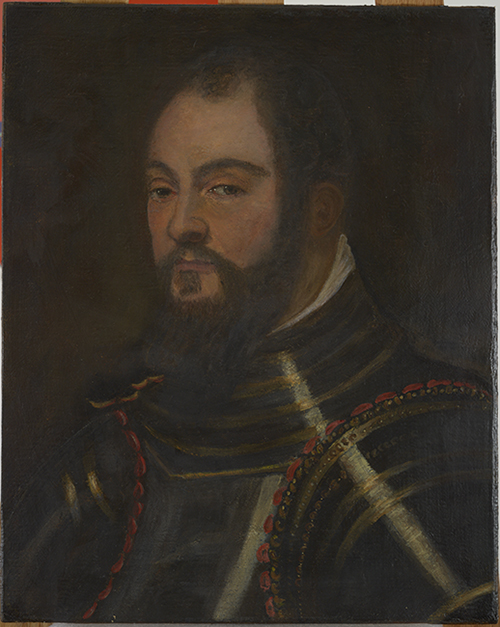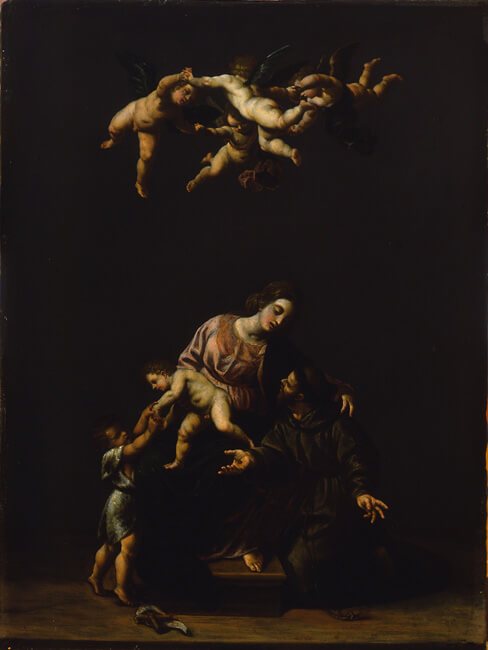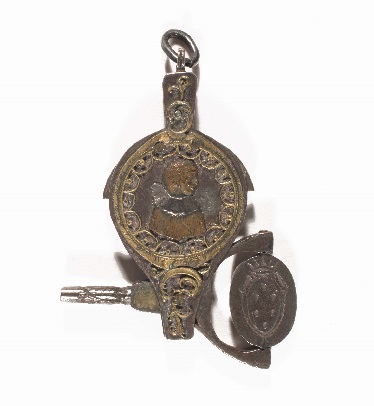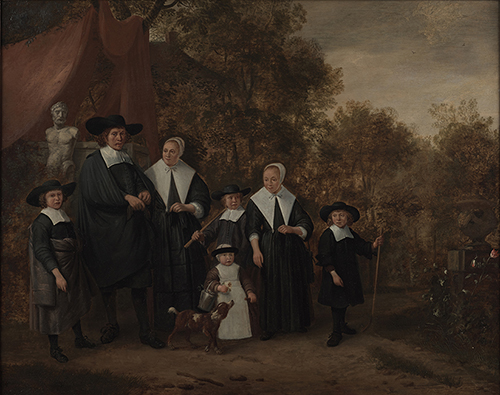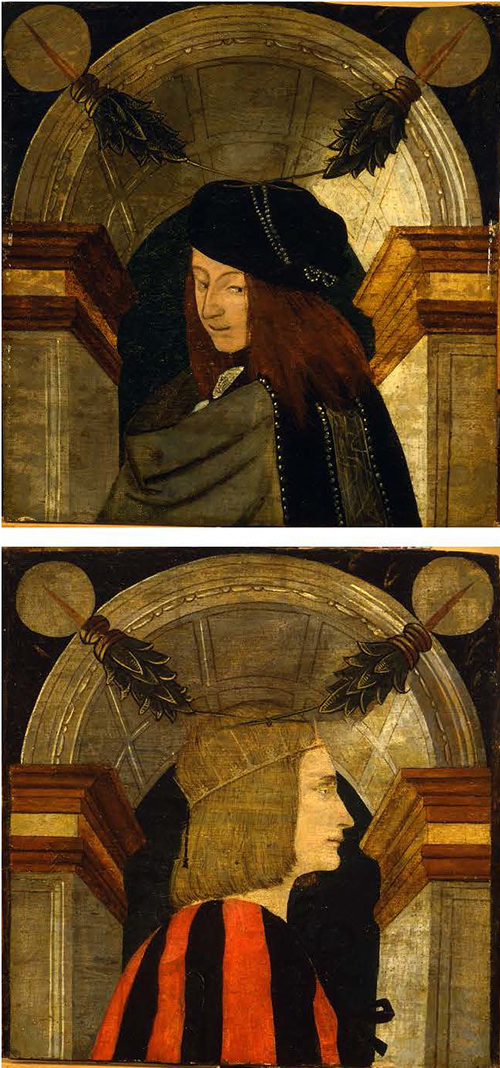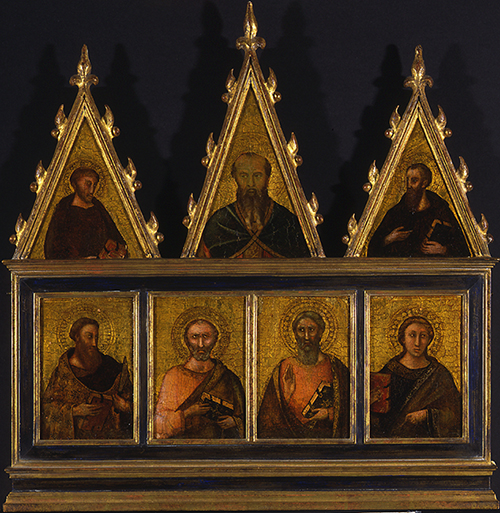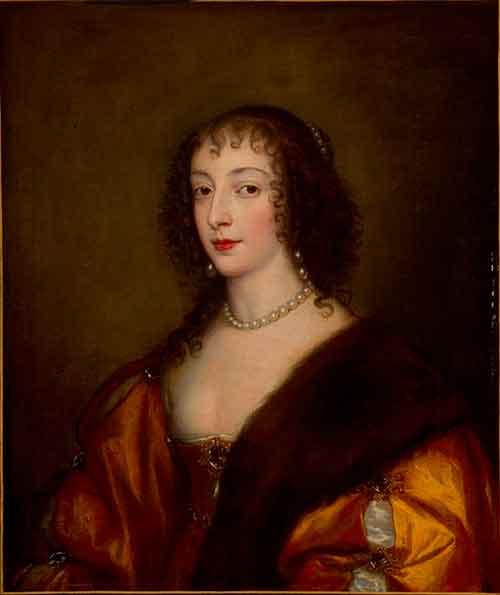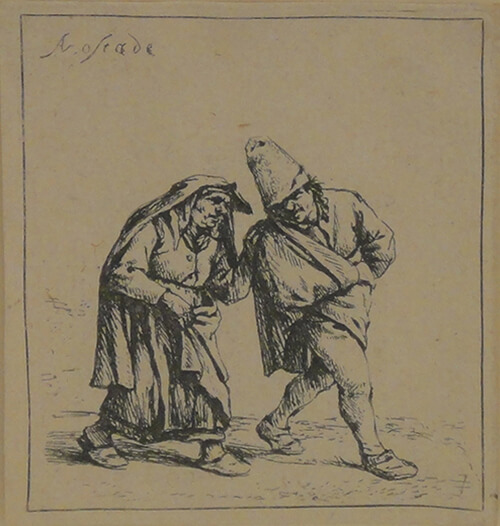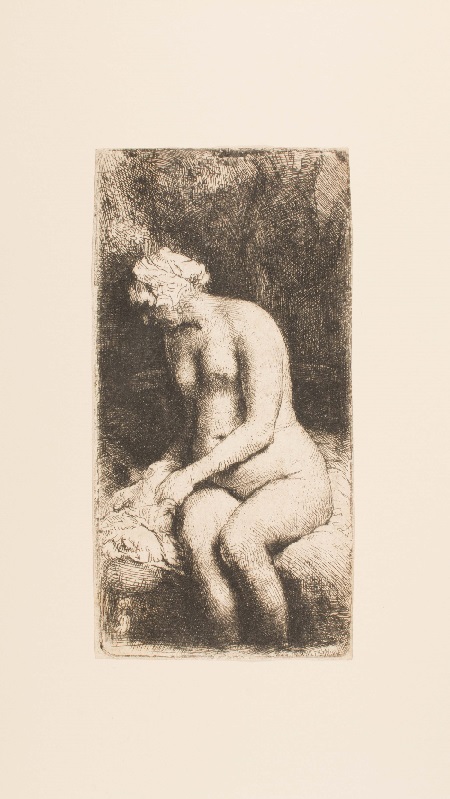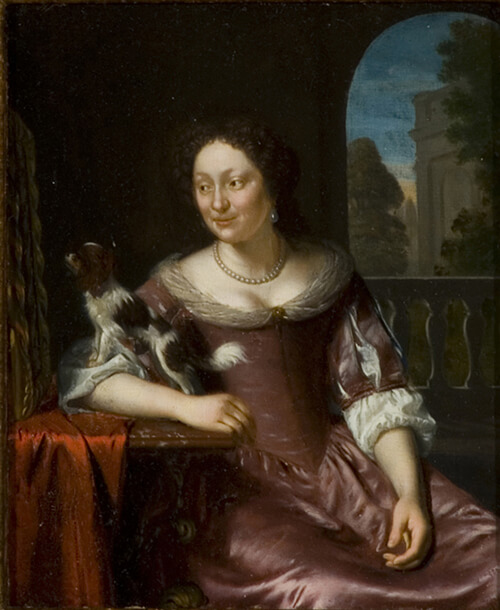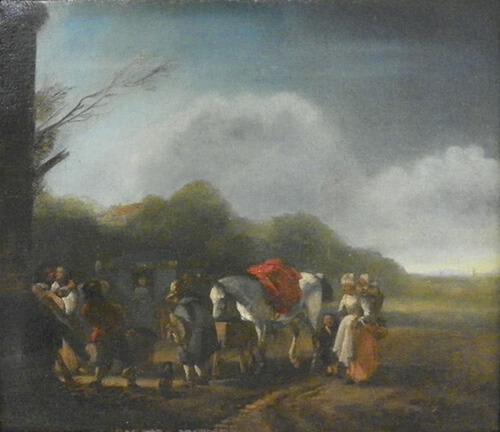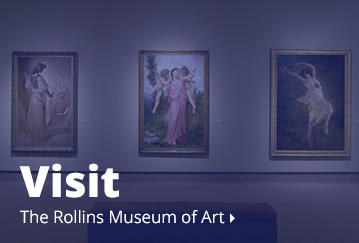Old Masters (to 1800)
Perhaps nobody has contributed as much to helping the Rollins Museum of Art become the only museum in the area to have remarkable European Old Masters than the family of John C. Myers, Sr.: the works they donated, starting in the 1950s and continuing through today, remain the core of our Old Masters collection, and include paintings by Gerolamo Bassano (1566-1621), Giovanni Domenico Tiepolo (1727-1804), Jean Baptiste LePrince (1734-1781), Thomas Lawrence (1769-1830), Franz De Paula Ferg (1689-1740), among others. Later donors added to the collection works by Pietro Liberi (1605-1687), Thomas Gainsborough (1727-1788), Alberto Pasini (1826–1899), George Romney (1734–1812), Marius-Jean-Antonin Mercié (1845–1916), and Dirk Hals (1591-1656), and many others. Today European art continues to be one of our collecting priorities, as we try to expand the story of art that our collection teaches. Significantly, the first purchase made by the museum once acquisition endowments were set up was a print by Albrecht Dürer (1471-1528), The Seven Trumpets (From the Apocalypse); other purchases, including prints by Giovanni Domenico Tiepolo, a drawing by Luca Cambiaso (1527–1585) and a painting by Francesco Solimena (1657–1747), followed.
PLEASE NOTE: Not all works in the Rollins Museum collection are on view at any given time. View our Exhibitions page to see what's on view now. If you have questions about a specific work, please call 407-646-2526 prior to visiting.
Artists Featured in This Section
Andrea Andreani
(Mantuan, 1558/59-1629)The Entombment, Florentine, 1585
Chiaroscuro woodcut on paper
16 1/4 x 12 3/4 in
Purchased with the Wally Findlay Acquisition Fund, 1991.7
Andrea Andreani, born in Mantua and active in Rome, Florence and Siena, was the only Italian printmaker who created a sizeable number of chiaroscuro woodcuts in the late sixteenth century. Chiaroscuro woodcut is a type of print made from multiple woodblocks that are inked in closely related hues of colors, rather than from one block. The printed image resultant from this process creates an effect of chiaroscuro (meaning “light and shadow” in Italian) analogous to that in painting—that is, three-dimensional modeling effect through shading and lighting. It also creates a pictorial approximation to an ink-and-wash drawing and a hand-colored print. The Entombment by Andreani was made from four separate blocks.
The subject of the print, the entombment, was a very popular theme in Christian art, depicting the moment when the Christ’s dead body is about to be placed in a tomb, and all the attendants mourn. Here, Joseph of Arimathea, lost in deep sorrow, supports the lifeless body, and behind him, John the Evangelist weeps. In the foreground, the grieving Virgin Mary has fainted out into the arms of Mary Magdalene. Another Mary who is said to have also witnessed the event dramatically opens her arms in disbelief, expressing her immense anguish.
As the inscription at the bottom left tells us, Andreani’s engraving is dated to 1585, and it faithfully reproduces a painting by Raffaellino da Reggio, a little-known Florentine painter. This inscription also indicates that the print is dedicated “to the most illustrious and excellent Signor Don Giovanni de Medici.” It is speculated that Giovanni may have commissioned Andreani—who was then working in Florence—to reproduce da Reggio’s design, because it is quite unusual that Andreani reproduced a work by such a minor artist.
Anonymous Italian engraver (the so-called School of Marcantonio Raimondi) after Giulio Romano
(Italian, ca. 1499-1546)The Horatii and the Suriatii, ca.1541
Engraving on paper
11 1/8 x 16 1/8 in.
Purchased with the Wally Findlay Acquisition Fund, 1996.23
Signature/Date/Inscription: TRIGEMINORVM HORATIORVM / CVRIATIORVM. Q. PRO PATRIA / GLORIOSVM CERTAMEN. // ANT. SALAMANCA. EXCVDEBAT. / ROMAE. AN. 1541
The inscription on the decorative cartouche informs us that Antonio Salamanca (1478–1562) published this work in Rome in 1541. It also identifies the print’s subject as the glorious combat between the Horatii and the Curiatii. According to Roman legends, these pairs of triplet brothers fought to settle the war between Rome and Alba Longa. Salamanca, a Spaniard by birth, settled in Rome and was very successful as publisher and dealer of printed images. The vast majority of those bearing his name and address are engravings by unknown artists, as is the case for RMA’s example. The designation, “the school of Marcantonio Raimondi,” refers to anonymous sixteenth-century printmakers whose graphic techniques are indebted to that of the influential Italian printmaker, Raimondi (ca. 1470/82–1527/34).
This unknown engraver did not conceive the composition by himself; instead, he copied a fresco painting by the celebrated architect and artist Giulio Romano (ca. 1499–1546). In 1527–1534, Romano designed the famous Palazzo del Tè in Mantua for Duke Federico II Gonzaga (1500–1540), and he also decorated many of its rooms with mural paintings. One of these chambers, called Sala dei Venti (“room of the winds”), has its vaulted ceiling richly frescoed with various scenes including zodiac signs, and its upper wall, with sixteen medallions. This engraved image derives from one of these roundels, one that represents a combat of gladiators. The engraving differs from Romano’s fresco only in details, such as its background and format. Its composition is also reversed like a mirror image.
Baccio Baldini
(Italian, 1436-1487)Dante and Virgil with a Vision of Beatrice, ca. 1481-7
Engraving on paper
3 3/4 x 6 3/4 in.
Gift of Mrs. Ruth Funk, 2001.4.1
Dante and Virgil, with a Vision of Beatrice belongs to a series of engravings that illustrate the first nineteen cantos of Dante’s Inferno, the first part of the Divine Comedy. Meant to visualize the dialogues between Dante and his guide in the second canto, this represents the pair of poets twice, depicting two stages. Shown on the left is Dante, who expresses to Virgil his flagging confidence before setting off on the journey down to Hell. In the middle, the Roman poet reassures Dante by relating how Beatrice, Dante’s deceased love, came down from Heaven to Limbo and asked him to help save Dante from the latter’s plight. Encouraged Dante follows Virgil toward the Gate of Hell, which is rendered here in a rugged terrain on the right. Inscribed above the entrance, “PER ME” (“Through me” in Italian) are the first words of the three opening lines of the third canto.
The consensus is that Baccio Baldini, a Florentine goldsmith and engraver, created this series of nineteen prints based on Sandro Botticelli’s lost drawings. Though hardly reflective of Botticelli’s sophisticated draughtsmanship, Baldini’s engravings are historically significant. With their clear, thick contour lines and fine cross-hatchings for shading, they exemplify what is called the Fine Manner, one of two principal styles in early Italian intaglio prints (such as engravings and drypoints, whose images are incised into a metal surface). Baldini’s work also informs us about the technical difficulties in producing engraved illustrations for printed books in the late fifteenth century. His Inferno prints were originally intended as book illustrations for a 1481 edition of the Divine Comedy, issued in Florence with a commentary by the great humanist Cristoforo Landino (1424–1498). This publication was supposed to be fully illustrated, with one engraving for each canto. Most surviving copies, however, contain no more than the first two plates, testifying to a failed attempt at embellishing a printed book with engravings, rather than with crude woodcuts as normal at that time. The Florentine edition of the Divine Comedy was only the sixth, and by far the most ambitious, experiment of that kind in Italy. Such trials were soon abandoned, not to be taken up again until the late sixteenth century.
Dating Baldini’s engravings has long been contested. Now they are generally dated around 1481–1487: that is, begun after completing the printing of the text and interrupted with the engraver’s death.
Cesare Bassano after Luca Ciamberlano
(Italian, fl. 1599–1641)Saint James the Greater, ca. 1606–1607
Engraving on paper
24 x 31 in.
Gift of George H. Sullivan, 1950.23
According to medieval legend, after his martyrdom in Jerusalem the apostle St. James’ remains were miraculously brought to Compostela in Galicia, Spain, where he had previously proselytized. The apostle’s supposed burial place, Santiago de Compostela, has long been one of the most popular pilgrimage destinations for Christians since the Middle Ages. The RMA's impressive engraving follows a long-established visual convention by depicting St. James the Greater as a pilgrim, who holds a long walking staff in his hand and wears a wide-brimmed hat adorned with a scallop shell. The shell is a proud token worn by pilgrims who made it to Santiago de Compostela for centuries, and in the visual arts, it serves as St. James’s principal attribute.
This large engraving (24 x 31 in), Saint James the Greater, belongs to a suite called Il Sacro Santo Senato di Giesu Christo (The Holy Senate of Jesus Christ), published in Siena in 1607. The series includes bust-length images of Jesus, the Virgin Mary, and the twelve Apostles, and as seen in this engraving, each bears a short biographical text about the depicted figure at the bottom. The series was executed by three skillful, yet lesser-known, Italian engravers: Domenico Falcini, who published the series himself; Luca Ciamberlano; and Cesare Bassano (also spelled Bassani). Saint James the Greater carries Bassano’s signature, “C. Bassani F[ecit],” on the staff, as well as Ciamberlano’s monogram—consisting of his initials L and C—on St. James’ hat. These suggest that Bassano engraved (“fecit” meaning “made”) the work based on a drawing by Ciamberlano.
This almost life-size pseudo-portrait of St. James creates an effect of speaking likeness; the saint turns around to his right and gazes outward with his lips slightly parted, as though responding to, or speaking to, the viewer. Though little is known about Bassano, his skills in handling the engraver’s tool is undoubted and well demonstrated in the rendering of the wavy, rippled texture on the rim of the hat, beautifully capturing the moiré effect.
Gerolamo Bassano
(Italian, 1566-1621)Noah Leading Animals into the Ark, ca. 1595
Oil on canvas
30 1/4 x 36 in.
Gift of Marjorie Myers Ginn, Francis B. Myers II, John C. Myers, Jr., and Everett M. Myers in memory of John C. Myers, Sr., 1957.4
The patriarch of the Bassano family, Jacopo Bassano (ca. 1510–1592), was active in Bassano del Grappa (Veneto). He popularized genre-like paintings with biblical narratives, in which peasant figures, animals, and still-life details predominated. Such works were common in the Netherlands, but not in Italy before Jacopo. They quickly became very popular, and his sons Francesco (1549–1592), Giambattista (1553–1613), Leandro (1557–1622) and Gerolamo (1566–1621) joined a large and busy workshop. As a result, many of the Jacopo’s compositions exist today in multiple versions, which makes it extremely difficult to differentiate Bassano brothers’ hands.
This painting depicts Noah’s family preparing for the Great Flood (Genesis 6–7). A multitude of animals arrive from the right and wait to enter the ark. Seen from behind at the bottom of the ramp, Noah guides them into the ark with the assistance of his three sons and a daughter-in-law, while his wife is busily packing provisions. The dark clouds in the background convey the ominous atmosphere before the impending Flood. The scene also contains delightful anecdotal details: dogs, hares, and sheep in the center foreground appear distracted, their attention drawn to a turtle. This composition survives in numerous versions and ultimately derives from Jacopo’s painting datable to around 1570, now in the Prado, Madrid.
Jacques Callot
(French, 1592-1635)Third Intermezzo of the Liberation of Tyrrhenus and Arnea, 1617
Etching
8 1/2 x 11 5/8 in.
Purchased with the Wally Findlay Acquisition Fund, 1996.4
This etching by the most virtuosic French printmaker of the seventeenth century, Jacques Callot, is the final one of the three that form The Intermezzi series. Callot, who worked for the Medici court in Florence between 1614 and 1621, created this suite in 1617 to commemorate a special theatrical production of The Liberation of Tyrrhenus and Arnea at the Medici Theater housed in the Uffizi. In February of that year, with numerous festive events, Florence was celebrating a significant political alliance: the marriage of Caterina de’ Medici (1593–1629), a sister of the Grand Duke of Tuscany Cosimo II (1590–1621), to the Duke of Mantua, Ferdinando Gonzaga (1587–1626). The libretto loosely based on classical mythology and its accompanying music were written for the occasion, and the performance incorporated a courtly ballet and tournament, as well as musical interludes, called ‘intermezzi’ in Italian, which explains the title of Callot’s etching series.
Occupying a magnificent piazza in the foreground and middle-ground of the Third Intermezzo are a multitude of jousting soldiers, musicians, and singers. Seated on the clouds in the sky are the goddess of Love and her celestial entourage playing musical instruments; they have come to intervene the cavaliers’ fight, and the chorus chant, “No more war, no more violence!” The open curtain framing the scene in the immediate foreground gives us an illusion that we are the audience in the theater, looking at the performance on the stage with a spectacular scenographic vista. The symmetric piazza is surrounded by pairs of monumental Corinthian columns, followed by a rectangular building with a projecting loggia on each side. This grandiose classical architectural setting continues into the far distance and ends with an arched portico topped with statues. The Cornell’s Third Intermezzo testifies to Callot’s virtuosity in conveying a real sense of depth and an aerial perspective, all with varying tones of black ink alone.
The Intermezzi series by Callot is considered a significant visual document of early theater arts, and in particular, that of the now lost Medici Theater, Florence’s first permanent theater that opened in 1586.
Jacques Callot
(French, 1592-1635)The Martyrdom of St. Sebastian, ca. 1632-33
Etching and engraving
6 1/4 x 12 3/4 in.
Purchased with the Jessie and Eugene Drey Foundation Endowment Fund, 1996.15
After leaving Italy in 1621, Jacques Callot first moved to Paris and then returned to his hometown Nancy, the capital of the Duchy of Lorraine. In the early 1630s until his death in 1635, he created over six hundred prints with various religious themes, including The Martyrdom of St. Sebastian.
According to the traditional hagiography, St. Sebastian was martyred in Rome at the order of the emperor Diocletian (245–311). As depicted in this etching partly enhanced with an engraving technique, the saint was shot by archers, but miraculously survived (only to be beaten to death later). Since the Middle Ages, this excruciating ordeal by archers’ arrows was the subject chosen to represent Sebastian, a popular patron saint invoked against plague.
Particularly noteworthy about Callot’s rendition of the story is its unusual composition. Sebastian is pushed into the middle ground and rendered diminutively, while the two archers and onlookers loom large in silhouette in the foreground. Yet Callot’s placement of the saint at the brightly lit center of the composition effectively draws the viewer’s attention to his vulnerable, half-naked lithe body bound to the pole, with three arrows piercing his arm, chest, and leg. Behind the pole on the ground are more arrows that have missed him. A large crowd of Roman soldiers and spectators witnesses his public execution at a safe distance. This imaginary site of his martyrdom is almost theatrical, filled with Roman ruins, from which trees and vegetation are growing. Especially impressive is the crumbling, yet still majestic, amphitheater on the left. Farther in the distance, a splendid city rises above the horizon line, reminiscent of seventeenth-century Rome, where Callot had once worked.
The artist’s choice of the subject matter can be interpreted in several different ways. As the plague was rampant in Lorraine in the 1630s, Callot may have responded to the print market demanding images of this anti-plague saint. In addition, during this era of intense religious conflicts, Lorraine was a stronghold of Catholicism, where Protestants were frequently executed in the public, as early Christians had been by Romans.
At the bottom are two different signatures, one by the artist (“invented and made by Callot”) and the other by the French print publisher, Israël Silvestre (1621–1691) (“published by Israël Silvestre with the royal privilege”).
Luca Cambiaso
(Genoese, 1527-1585)Madonna Della Misericordia , ca. 1570
Pen and brown ink, black chalk, and brown wash on laid paper
Purchased by the Wally Findlay Acquisitions Fund, 1992.1
The drawing’s subject, known as the Madonna della Misericordia, or the Virgin of Mercy, represents Mary as merciful intermediary between Christ and the devout, sheltering the faithful under her wide open mantle held by two angels. In this pen-and-ink drawing attributed to Luca Cambiaso, the towering Virgin gently gazes down at, and blesses, male prayers gathering on her right side. Echoing her blessing gesture with an extended arm, the Christ Child nesting in her arm looks toward the flock of the kneeling females on his left.
A Genoese artist, Cambiaso is well-known for his distinctive draftsmanship. With rapid pen strokes, he drew simplified, yet clear forms in lines, and with ink wash applied in broad brushstrokes, emphasized figures’ plastic volumes and the fall of light and shadow on forms. Cambiaso’s drawings were so influential and highly valued that already in the late sixteenth century, other artists frequently copied them and imitated his vigorous technique, which complicates identifying the master’s authentic drawings from his imitators’. What makes the task of authenticating the authorship of Cambiaso’s even more difficult is that the artist incessantly drew not only as preparatory studies for his paintings, but also as autonomous works in themselves. His Genoese patrons in fact collected them as fully finished artworks. Though none of Cambiaso’s extant paintings represent a Madonna della Misericordia, the artist could have created this drawing as an autonomous work. It cannot be ascertained, at this point, whether the Madonna della Misericordia is by Cambiaso himself; Giovanni Battista Paggi (1554 – 1627) has been suggested as a potential alternative attribution. Either way, this stunning drawing undoubtedly demonstrates a masterful draftsmanship, which closely resembles that of the celebrated Genoese artist, especially around 1570.
Unknown, In the manner of Pieter Claesz
(1597 -1660)Still Life with Beaker, Glass and Fruit, ca. 1660
Oil on Canvas
18 1/4 x 25 1/4 in.
Gift of the Myers family, Mr. and Mrs. John C. Myers, Jr., ’42 and June Reinhold Myers ’41, 1960.15
The work is produced in the style of the seventeenth-century Dutch artist Pieter Claesz, known mostly for his still lifes, and particularly his monochrome banketjes (banquets) and ontbijts (breakfast pieces). There is a long tradition of still-life and genre painting in the Netherlands, which continued into this Golden Age. Such still lifes not only function as a document of everyday items, but can serve as moral or religious symbols.
Claesz’s work often dwells on the difference of surface texture and responses to light. The use of a naturalistic style, optical illusion, and a low foreground draw the viewer into the scene. Such paintings of food and household objects can be read as either celebrations of material possession or as “vanitas” scenes, a meditation of the transience of life. Both interpretations are relevant given that the Dutch Republic was at once religious and moralistic, as well as mercantile and proto-capitalist.
Circle of François Clouet
(French, 1516/22–1572)Portrait of King Charles IX of France, ca. 1561
Oil on oak panel
8 x 5 7/8 in.
Gift of the Myers family, Mr. and Mrs. John C. Myers, Jr., ’42 and June Reinhold Myers ’41, 1976.1
Trained by his equally famous artist father, Jean Clouet (1480–1541), François succeeded him as court painter in 1540 and served four successive Valois monarchs, from Francis I (r. 1515–1547) to Charles IX (r. 1560–1574). The Valois had a keen interest in commissioning dynastic portraits. Charles IX, with his droopy eyelids characteristic of the dynasty, gazes out at the viewer sideways, with an inscrutable expression. In 1561, the 11-year-old king was the most eligible bachelor in Europe. During the early modern era, high-quality multiples of royal portraits were frequently made as gifts for family members and for diplomatic purposes, such as negotiating and arranging dynastic marriages.
Royal portraits during the Renaissance were first and foremost portraits of costume. Charles IX is indeed elegantly dressed in this painting, embodying the international European fashion among royal and aristocratic men in the late-sixteenth century. He wears an embroidered black doublet (close-fitting padded jacket), a matching jerkin (sleeveless jacket worn over the doublet) lined with fur, and a floppy cap adorned with ostrich feathers.
Attributed to Marcellus Coffermans
(Flemish, 1520–1578)The Crucifixion with Saint John the Virgin Mary and Mary Magdalene, ca. 1550
Oil on canvas mounted on panel
16 1/2 x 12 1/4 in.
Gift of Marjorie Myers Ginn, Francis E. Myers II, John C. Myers, Jr. ’42, and Everett M. Myers in memory of John C. Myers, Sr., 1957.14
Marcellus Coffermans was a sixteenth-century Flemish painter best known for his works heavily drawing upon earlier Flemish masters. The composition of The Crucifixion is loosely derived from the central panel of Rogier van der Weyden’s much admired Crucifixion Triptych (1443/45). The dead Christ’s pose and clenched hands, as well as his emaciated, naked body covered by a flowing loincloth, are particularly close to the original. Other common Flemish types echo van der Weyden’s immense influence: St. John the Evangelist, extending his arms to support the swooning Virgin Mary, and Mary Magdalene, mourning at the foot of the cross. The skull and bones in the foreground identify the site of the crucifixion as Golgotha. Typical of Northern Renaissance paintings, the holy city of Jerusalem in the backdrop has morphed into a fortified European town.
François Collignon
(French, ca. 1610–1687)Two Dwarfs Dueling, ca. 1630-35
Etching on paper
4 x 5 1/2 in.
Gift of anonymous donor, 1984.6.17
The small etching Two Dwarfs Dueling is ascribed to François Collignon, a French engraver who was highly successful in Paris and Rome as print-seller and publisher, more than as printmaker. His prints demonstrate the great influence of his teacher, Jacques Callot, as well as, of della Bella, although they do not rise to the artistic quality of either. Collignon had a particularly close working relationship with his more gifted friend della Bella, copying and publishing the latter’s works.
Two Dwarfs Dueling, one of Collignon’s four burlesque etchings that represent groups of little people, offers an intimate close-up view of two well-dressed dwarfs in duel, both armed with disproportionately large fencing swords. Along with a number of other prints and drawings with varying dwarf themes by Collignon’s contemporaries (including della Bella and Callot), this etching offers us a fascinating glimpse into the courtly culture and popular entertainment in seventeenth-century Europe. As most amply documented at the court of the Medici Grand Dukes in Florence, dwarf entertainers performed horse races, jousting tournaments, and masquerades to entertain the people during various public festivals, ranging from ducal weddings to carnivals. Dwarf characters were also often featured in literary works and theater pieces of the time, as the burlesque and giocoso (“jocular” in Italian) genres were being established in the seventeenth century. Collignon’s etching, which seems to mock chivalrous exercises, well reflects this lesser-known aspect of seventeenth-century European culture.
Stefano della Bella
(Italian, 1610-1664)The Medici Vase, 1656
Etching on paper
12 x 10 3/4 in.
Purchased with the Wally Findlay Acquisition fund, 1991.8
Stefano della Bella was a prolific Florentine etcher and draughtsman, active in Florence, Rome, and Paris. The Medici Vase is considered one of his finest prints, which della Bella’s contemporary and biographer of artists, Filippo Baldinucci (1625-1697) already praised in his Life of the Artists in 1681. As inscribed in Latin on the bottom margin, the artist created this work in Rome in 1656, representing a famous Greek marble vase that was in the Medici’s collection from the late sixteenth century and displayed in the garden of the Villa Medici on the Pincian Hill. Now known as the Medici Vase and located in the Uffizi Gallery in Florence, this five-foot-tall krater datable to the second half of the first century A.D. was one of the most celebrated and copied antique vases in Europe until the nineteenth century. Della Bella’s etching is often noted as the earliest, and most beautiful, visual record of the Medici Vase. This bell-shaped vase is decorated with acanthus leaves and a continuous narrative frieze comprising eight figures carved in high relief. The tradition dating back to the late sixteenth century identifies the mysterious scene on the frieze as the sacrificial story of Iphigenia. The three figures visible in della Bella’s representation are generally considered to be Iphigenia (crouching below the statue of Diana), her father Agamemnon, and Ulysses.
As noteworthy as the vase in this print is the boy seated next to and sketching the monumental antique marble. He has been plausibly identified as the then fourteen-year-old heir to Ferdinando II de’ Medici (1610-1670; r. 1621-1670), later Grand Duke Cosimo III (1642-1723; r. 1670-1723). In the 1650s, della Bella was employed at the Medici court, and as the young prince’s drawing teacher, he accompanied Cosimo to Rome in 1656, the year when this etching was executed.
Albrecht Dürer
(German, 1471 - 1528)The Seven Trumpets, from the Apocalypse series, ca. 1511
Woodcut on paper
15 1/2 x 11 in
Museum Purchase from the Wally Findlay Acquisition Fund, 1992.7
Albrecht Dürer achieved international fame early in his career with the publication of his groundbreaking Apocalypse series in 1498. This folio-sized illustrated book comprises 15 full-page woodcuts and the complete text of Revelation, the last book of the Bible that prophesies cataclysmic events signaling the second coming of Christ.
The Seven Trumpets, the seventh woodcut in the series, visualizes events described in Revelation 8:1–13 and 9:1–12. In the upper half of the composition that represents the heavenly realm, four angels blow their trumpets, while God hands out the last two trumpets behind an altar. In the lower half, the earth is struck with catastrophic occurrences upon the opening of the seventh seal. Towns and the sea burn in flames, and locusts fall from the sky to torture people. A “great mountain burning with fire” is thrown into the sea which destroys one third of the ships and living creatures in the water. The woodcut shows remarkable black lines of varying qualities in thickness, density, and length. Inscribed on the lower edge is Dürer’s famous monogram consistingFranz de Paula Ferg
(Austrian, 1689-1740)The Building of Noah's Ark, ca. 1730
Oil on panel
9 x 12 1/2 in.
Gift of Marjorie Myers Ginn, Francis B. Myers II, John C. Myers, Jr., and Everett M. Myers in memory of John C. Myers, Sr., 1957.10
Born in Vienna, Franz de Paula Ferg was a painter and printmaker who specialized in small landscapes and outdoor genre scenes, often presenting well-populated markets and villages. The Building of Noah’s Ark is archetypical of Ferg’s small-scale oil paintings peopled by a multitude of tiny figures and animals and created with a somewhat dark palette. In the shaded foreground is a group of onlookers—men, women, and children. Under construction in the distant middle ground is the monumental ark. Countless workers, rather than just Noah and his family, are busily engaged with various building activities. Donkeys, oxen, and horses pull carts and wagons carrying construction materials. In the lower right corner, blacksmiths work on wagon wheels. This work belongs to a particular type of painting called “world landscape.” This genre, which originates in Netherlandish art in the early sixteenth century, offers a bird’s-eye panorama of a vast terrain and normally portrays religious subject matter.
Lavinia Fontana
(Italian, 1552-1614)The Dead Christ with Symbols of the Passion, ca. 1581
Oil, tempera on panel
14 1/4 x 10 5/8 in.
Gift of the late General and Mrs. John J. Carty, in memory of her brother, Thomas Russell, 1936.30
Lavinia Fontana, born in the progressive city of Bologna, was one of the most successful and prolific women artists in sixteenth-century Europe. She received her initial training as a painter from her artist father, Prospero Fontana (1512–1597), who had her develop her artistic potential and obtain a humanistic education, and who helped forge her public image as a refined and educated woman artist.
Lavinia painted a large number of portraits, as well as small religious works such as The Dead Christ with Symbols of the Passion, which were meant to aid private devotion, helping the devout to contemplate upon Christ’s suffering and sacrifice for humanity’s redemption. The dead Christ’s ashen body is emphatically presented to the viewer by a pair of angels. They are in turn flanked by two others on each side who hold instruments of Christ’s Passion: the column, the cross, and three nails. In the foreground lie a crown of thorns and a whip, objects signifying the mocking and flagellation of Christ.
Thomas Gainsborough
(British, 1727–1788)Portrait of Gaëtan Apolline Balthazar Vestris, ca. 1781
Oil on canvas
12 ½ x 10 ⅜ in.
Bequest of Edmund L. Murray, 1983.14
Thomas Gainsborough was one of the most sought-after society portraitists in Georgian England (1714–1830). While his life-size portraits marvel viewers with his bravura brushwork and incredibly bold and free handling of paint, small works like this bust-length portrait show his fine “feathery” brushstrokes. The sitter in this painting, Gaëtan Apolline Balthazar Vestris (1729–1808), was a French ballet dancer who earned the moniker “God of Dance” as the star of the Paris Opéra. Despite his age, he was still the most celebrated dancer in Europe, known for his virtuosity and innovative techniques.
All the hallmarks of the “dandyism” of the time—the simple, yet meticulously refined look of gentlemen—can be observed in this portrait. Gaëtan wears a well-tailored coat with wide lapels, a light-yellow silk waistcoat (or vest) underneath, and a white linen neck scarf carefully tied “in a waterfall of flowing layers.”
Francisco Goya
(Spanish, 1746-1828)Estan Calientes (They Are Hot), 1797-98
Etching and burnished aquatint on paper
8 ¾ x 6 in.
Museum purchase from the Wally Findlay Acquisition Fund, 1990.3
This etching by the renowned artist Francisco Goya y Lucientes comes from the book Los Caprichos, published in 1799. The title translates to “the caprices” or “the whimsies.” The book contains works of varying style and theme, which are all united by Goya’s pointed use of irony and satire. The artist addressed many controversial issues in Los Caprichos, criticizing the sins and shortcomings of everything from the aristocracy to the Church.
Estan Calientes is one of several of Goya’s etchings that is anti-clerical and anti-monastic and connects to the traditional connotations of the greediness and secret wantonness of the clergy. This work is striking despite its small size; the caricatured, grotesque faces and gaping mouths signify a ravenous appetite and represent the mindless gluttony of the Church. Ironically, the plates before these figures are empty, indicating that this hunger will never be satisfied. This image was highly controversial when Goya first published it in the Diario de Madrid on February 6, 1799. Despite, or perhaps because of, the initial controversy, Los Caprichos is now one of Goya’s most well-known works and contributed to his fame outside of his home country of Spain.
Francisco de Goya
(Spanish, 1746-1828)Otras Leyes Por El Pueblo, 1819
Etching
11 3/4 x 17 1/2 in.
Dana Wolf/Chauncey Lowe, 1991.14
Francisco de Goya
(Spanish, 1746-1828)Que pico de Oro! (What a Golden Beak!), 1797-1798 published 1799
Original etching: drypoint, aquatint, engraving
13 x 9 3/8 in.
Gift of Mrs. Ruth Funk, 2001.4.5
Anton Graff
(Swiss, 1736–1813)Portrait of a Lady, ca. 1795–1800
Oil on canvas
23 1/4 x 18 1/2 in.
Gift of Mr. and Mrs. Everett M. Myers, 1963.6
Dirck Hals
(Dutch, 1591-1656)An Elegant Company Playing a Game of Trictrac in an Interior, ca. 1650
Oil on panel
23 1/8 x 29 1/2 in.
Donated in memory of Robert G. Scully, 2018.22
Dirck Hals
(Dutch, 1591-1656)An Elegant Company Playing Music in an Interior, ca. 1640
Oil on panel
20 7/8 x 27 1/8 in.
Donated in memory of Robert G. Scully, 2019.1
William Hogarth
(English, 1697-1764)Paul Preaching before Felix, 1752
Engraving and etching
10 ½ x 13 7/8 in.
Gift of Norman Bradish, 1959.6
Known for political satire and societal critiques, Hogarth drew inspiration from French, Italian, and Dutch paintings and engravings for his caricatures of contemporary English society. This etching parodies the style of Dutch artist Rembrandt van Rijn (1606-1669) and features the biblical story of Paul Before Felix in which Saint Paul stands on trial before the orator Tertullus and the governor Felix. Here, Hogarth utilizes a historic narrative to create a tongue-in-cheek commentary on the well-publicized hoax performed by Benjamin Wilson (1721-1788). In 1751, Wilson created two imitation Rembrandt etchings, and sold his forged works to expert connoisseur Thomas Hudson (1701-1779) after a feud they had over the purchase of a Rembrandt etching. The specialist’s gullibility was exposed during an “English roast” in which several artists were present, including Hudson.
This print also comments on current political events of Jacobite William King (1685-1763) by alluding to King’s notorious Latin proclamation filled with Jacobite ideals. Society denounced King and his political sentiments for the harmful effect it had on young individuals.
Jean Baptiste Le Prince
(French, 1734 - 1781)Spring, 1763
Oil on Canvas
19 1/2 x 34 3/8 in.
Gift of the Myers Family. Mr. and Mrs. john C. Myers, Jr., '42 and June Reinhold Myers, '41
These four canvases each depicts a languid female nude, possibly Venus, reclining on clouds draped with rumpled silk, accompanied by either one or two winged putti (or cupids). Previously called the “Four Seasons,” it is unknown whether these paintings comprise a suite. Ony two of them contain seasonal references: the woman holding a scythe and a bundle of wheat could be Ceres, Roman goddess of agriculture often linked with summer, and the woman with grapes may be a bacchante who, by association with Bacchus, could refer to autumn.
Mythological subjects were often pretexts for painting female nudes, which were a recurring theme in French Rococo paintings. Loosely unifying them are emblematic motifs of love, such as white doves and roses (attributes of Venus), a quiver with arrows (Cupid), grapes (Bacchic symbol), and two burning hearts in flame.
Jean Baptiste Le Prince
(French, 1734 - 1781)Summer, 1763
Oil on Canvas
19 1/2 x 34 3/8 in.
Gift of the Myers Family. Mr. and Mrs. john C. Myers, Jr., '42 and June Reinhold Myers, '41
Jean Baptiste Le Prince
(French, 1734 - 1781)Autumn, 1763
Oil on Canvas
19 1/2 x 34 3/8 in.
Gift of the Myers Family. Mr. and Mrs. john C. Myers, Jr., '42 and June Reinhold Myers, '41
Jean Baptiste Le Prince
(French, 1734 - 1781)Winter, 1763
Oil on Canvas
19 1/2 x 34 3/8 in.
Gift of the Myers Family. Mr. and Mrs. john C. Myers, Jr., '42 and June Reinhold Myers, '41 1963.5
Blondel le Roman
(French, 18th century)Untitled (Reclining Male Nude), 18th century
Graphite on light blue prepared paper
20 3/4 x 15 19/32 in.
Purchased with the Michel Roux Acquisitions Fund, 2007.8
Inscription: “fait a rome par Blondel leroman/ architecte et member de d’accademie de Marsseille.”
An inscription in French on the bottom left of the drawing identifies its draughtsman as Blondel le Roman, architect and member of the Academy of Marseilles, and places its creation in Rome. Handwritten in iron gall ink, now faded to brown, it is undoubtedly a later—most likely, late-nineteenth-century—addition to the graphite drawing datable to the eighteenth century. In the past, the inscription had led to the erroneous attribution of this drawing to Jacques-François Blondel (French, 1705–74), one of the most influential eighteenth-century French architects and theorists. However, this identification appears implausible, as there seems to be no other extant figure study by Jacques-François. Nor did he ever belong to the Academy of Marseilles. Until further research is undertaken, the true identity of the artist called Blondel le Roman cannot be determined.
Regardless of the artist’s identity, the drawing’s masterful draftsmanship is unquestionable. Its subject, a reclining male nude, as well as its manner of execution in graphite on light blue prepared paper, all corroborate that the artist would have been a member of an Academy. The Academy refers to an institution established in major European cities in the seventeenth and eighteenth centuries to train budding artists with all the skills and knowledge required to work in the grand manner of history painting (the most esteemed art genre for centuries). Drawing nude figures from life was a core part of the curriculum, intended to instill knowledge of, and hone skills to represent, ideal human bodies. Teachers who were respected artists and students alike made such drawings, which came to be known as academies. This drawing is a superb eighteenth-century example of academy.
A course of drawing nude figures from life in an Academy was preceded by a lengthy training based on two-dimensional models (such as engravings and drawings) and then on three-dimensional casts. Although the Academy’s insistence on discipline has been criticized with the rise of Modernism, it cannot be denied that rigorous academic training helped produce superb draughtsmen, as seen in this Cornell drawing.
Pietro Liberi
(Italian, 1605 -1687)Europa Crowned, ca. 1645-50
Oil on Canvas
57 x 44 in.
Bequest of the estate of Virginia S. Nelson, 1992.16.8
According to Ovid’s Metamorphoses, Europa was a Phoenician princess with whom Zeus fell in love. He approached her by changing his form into a white bull. When she rode on his back, he swiftly carried her away to the island of Crete. Liberi deviates from the traditional representation of the story, which depicts Europa on the bull, either on the shore before her abduction or in the water. Instead, she is here accompanied by a small brown—not white—bull and embraces a man clad in a rich, white garment who is about to bestow a crown and a laurel wreath on her. While the precise allegorical meaning is difficult to decipher, it is possible that the man in white is Zeus transformed back from a bull to his original form. Given the foreshortened figures, as though seen slightly from below, the painting was originally meant to be viewed above eye level.
Bernardino Di Mariotto
(Italian, 1478-1566)Saint Nicholas of Tolentino, Early sixteenth century, Tempera on panel
13 x 6 in.
Gift of Marjorie Myers Ginn, Francis E. Myers, II, John C. Myers, Jr. ’42, and Everett M. Myers in memory of John C. Meyers, Sr., 1957.8
Bernardino di Mariotto was active in the Marches and Umbria regions of Central Italy. He was trained in Perugia under the local artist Ludovico di Angelo (d. after 1525); his style also shows indebtedness to the Crivelli brothers, Carlo (1430/35–1495) and Vittore (1444/9–1501), in whose workshop he may have worked for a time.
The standing figure in full length is Saint Nicholas of Tolentino (1245/46–1305), dressed in the black habit of the Hermits of St. Augustine, a religious order founded in the thirteenth century. Believed to have performed three hundred miracles while alive as well as posthumously, Nicholas was venerated soon after his death and canonized as a saint in 1446. According to legend, a star flashed across the sky from his birthplace in Sant’Angelo-in-Pontara and appeared at the door of his cell in Tolentino, where he spent much of his later life until his death, preaching and leading an ascetic life; the star shining above him or on his breast as seen here is one of the saint’s attributes.
Attributed to Paulus Moreelse
(Dutch, 1571–1638)Portrait of a Lady, ca. 1620s
Oil on Canvas
34 x 35 in.
Gift of the Myers Family, Mr. and Mrs. John C. Myers, Jr.'42 and June Reinhold Myers'41, 1961.3
A leading portraitist in the early-seventeenth-century Dutch Republic, Moreelse was highly sought after by noble families, including those in the court of Prince Maurits of Orange-Nassau (1567–1625). Given the sitter’s stylish and luxurious dress, profusely adorned with jewels, she must have been a court lady in the House of Orange-Nassau. The boldly slashed sleeves of her black bodice are striking, revealing the bright-red underclothing. Slashes are pinked (cut zigzag) on the edge of each strip and marked with numerous small holes. This courtly woman is also bedecked with strands of pearl necklaces, as well as three large bodice ornaments, which became the “must have” piece of jewelry in the 1600s. Such elaborate gold jewels were commonly pinned like brooches at the center of the bodice and on sleeves, as seen in this painting. The red-ribbon rosette on the bosom of the sitter’s dress and the fan she holds in her right hand were enormously popular fashion accessories at the time.
Francesco de Mura
(Italian, 1696–1782)The Visitation, ca. 1752
Oil on canvas
37 x 46 1/2 in.
Gift of George H. Sullivan in memory of his parents, 1952.34
After Frans Pourbus the Younger
(Flemish, 1569-1622)Portrait of Marguerite de Valois, ca. 1610
Oil on panel
13 3/4 x 11 in.
Gift of Mr. and Mrs. Everett M. Myers in memory of John C. Myers, Sr., 1962.4
This unfinished bust-length portrait of Marguerite de Valois (1553-1615), queen of France and Navarre, is attributed to a follower of Frans Pourbus the Younger (1569-1622). Regardless of its uncertain attribution, this painting can be dated to the time of Pourbus’ activity in Paris between 1609 and 1622. The patterns and shapes of the jewelry worn by the queen resemble those frequently appearing in Pourbus’ portraits of royals and aristocrats, suggesting this unknown artist’s familiarity with the Flemish master’s works. Like the portrait of King Charles IX in the museum’s collection, Marguerite’s older brother, this painting pays particular attention to the sitter’s costuming. The décolletage, cut low at bust level, was popular in France in the early seventeenth century. The standing collar, edged with reticella (a needlepoint lace) and stiffened with starch, also demonstrates the popularity of such collars. These fine details of dress clearly indicate the wealth, status, and fashionability of the monarch.
School of George Romney
(British, 1734–1812)Portrait of an English Naval Officer, ca. 1780
Oil on canvas
29 1/2 x 24 in.
Gift of Mrs. H.A. Metzger and Stuart Borchard, 1959.23
Together with Joshua Reynolds (1723–1792) and Thomas Gainsborough (1727–1788), George Romney was one of the most fashionable portraitists in Georgian England (1714–1830). His Portrait of an English Naval Officer demonstrates well his artistic characteristics, such as his loose and expressive brushwork capturing the sitter’s individual features with remarkable efficiency. The portrait’s sensibility of feeling and mood and dramatically overcast pink-grey sky reflect the growing Romantic spirit of the time; its subject illuminates the significant social changes taking place in England during the eighteenth century. As the British Empire became a dominant political power thanks to its Royal Navy, naval officers—a rather new, meritocratic profession—emerged as key political and social figures. A great number of these men, who rose in ranks and acquired wealth during their service overseas, eagerly commissioned portraits to highlight their achievements.
Cosimo Rosselli
(Italian, 1439-1507)Madonna Enthroned Nursing the Christ Child, ca. 1470
Tempera, oil, gilding on panel
40 x 22 in.
Gift of the Samuel H. Kress Foundation, 1937.1
This altarpiece representing the Virgin Mary nursing the infant Christ is by Cosimo Rosselli, a Florentine artist best known for his participation in painting the walls of the Sistine Chapel in the Vatican in 1481–82. Mary is portrayed as the Queen of Heaven, majestically seated on a large throne decorated with gilded finials and spheres and wearing a blue mantel. The blue and red, the typical colors of her garments, symbolize her purity and sorrow. Mary’s outward gaze with a melancholic expression suggests her awareness of Christ’s destiny to be crucified for the salvation of humanity. Her depiction as a nursing mother emphasizes the humanity of both Mary and Christ. Given this altarpiece’s modest size and its imagery promoting an intimate relationship between the viewer and the sacred figures, it was most likely created for a private home or a small chapel in a church or convent.
Follower of Peter Paul Rubens
(Flemish, 1577-1640)The Virgin and Child Adored by Saints, ca. 1630
Oil on canvas
31 1/2 x 25 in.
Gift of Marjorie Myers Ginn, Francis B. Myers II, John C. Myers, Jr., and Everett M. Myers in memory of John C. Myers, Sr., 1957.11
This painting is a much smaller copy of Rubens’ grandiose high altarpiece for the Church of the Augustinian Fathers in Antwerp (completed in 1628). The fact that copies were made almost as soon as the altarpiece was installed speaks both to the artist’s fame and to the reception of the painting itself.
The composition follows the type known as a Sacred Conversation – a group of saints, here surrounding the Virgin and Child, brought together as if in dialogue. The saints depicted, who lived centuries and continents apart, are shown together because they were all important to the Augustinian order. Prominent among them, in the foreground and turning toward us, is St. Augustine himself. He is holding one of his attributes, a flaming heart, which refers to his book Confessions, where he wrote “you [God] have pierced by heart with the arrow of your love.”
Jan Saenredam after Abraham Bloemaert
(Dutch, 1565-1607; Dutch,1566-1651)Vertumnus and Pomona, 1605
Engraving on paper
18 3/4 x 14 1/4 in.
Purchased with the Anniversary Acquisition Fund, 1994.16
The story of love and seduction rendered in Vertumnus and Pomona is drawn from Ovid's Metamorphoses, the most popular classical literary source for visual artists in Renaissance and Baroque Europe. Vertumnus, the Roman god of changing seasons, fell in love with a beautiful nymph, Pomona, who was known for rejecting all her suitors and being dedicated to her gardens and orchards alone. Well aware of her reputation, Vertumnus approached her by disguising himself as an old lady, and he eventually convinced her of his love with his melodious voice.
In this large engraving by a seventeenth-century Dutch artist Jan Saenredam, Pomona is seated in the nude in the middle of her garden full of succulent fruits and vegetables; she holds a pruning knife, which is her attribute. The twenty-line poem printed in the lower margin, which the Dutch writer Theodore Schrevel (1572–1649) penned paraphrasing Ovid’s passages in Latin, describes Pomona’s lush garden like the following: “there are crooked cucumber, the pumpkin with its inflated body, the cabbage decumbent on an inclined stem, the cauliflower lying neglected among the undergrowth.” Saenredam depicts such natural details prominently in the foreground. Represented in a diminutive scale on the right corner of the background is the couple embracing under trees.
Sanraedam’s print is made after an oil painting (private collection) by his contemporary Abraham Bloemaert, an influential Dutch artist often called the ‘father of the Utrecht school’. Rather than slavishly reproducing the original, however, this talented engraver made substantial changes to enrich its garden setting. Bloemaert collaborated with many printmakers, who were engaged in reproducing his artistic inventions, and his contemporaries considered Saenredam as one of the best. Vertumnus and Pomona demonstrates this engraver’s incomparable skills in handling the burin (a tool with a sharp beveled point, used in engraving). By variegating lines and dots in black ink, he masterfully captures the effects of sunlight and shade that are characteristic of Bloemaert’s works, and creates tactile textures for all the different objects and figures, including Pomona’s soft, sunlit body.
Francesco Solimena
(Italian, 1657–1747)Saint Francis Xavier Baptizing the Indians, ca. 1680-1685
Oil on Canvas
19 x 25 in.
Museum purchase from the Michel Roux Acquisition Fund. In honor of Kenneth Murrah, 2014.5
Francesco Solimena was one of the most important Baroque painters active in Naples, bringing Neapolitan art to its pinnacle in the first half of the eighteenth century. His contemporaries claimed that everyone desired his works, testifying to his great success and popularity. His paintings are characterized by painterly brushwork and theatrical lighting effects reminiscent of Caravaggio’s (1571–1610) tenebrism and of Luca Giordano (1634–1705).
The protagonist of the scene is Saint Francis Xavier (1506–1552), who is depicted here standing in the center of the composition with one hand pointing toward heaven and the other holding a water jar. In this oil sketch, Solimena represents him in a priestly surplice and in the midst of baptizing the newly converted. Somber and dark colors dominate this work with patches of bright scarlet and blue concentrated in the foreground; sharp contrasts between light and shade create a sense of solemn drama. This is a preparatory oil sketch— called bozzetto in Italian—made for a larger-scale work, though the latter may or may not have been completed. Many Baroque painters, including Solimena’s celebrated pupil, Francesco de Mura (1696–1782), favored such a working method. Nicola Spinosa, an expert on Neapolitan art, dates the painting around 1680–85, based on its stylistic similarities to the Life of Saint Francis frescoes in the choir of Santa Maria Donnaregina in Naples.
Hendrick van Steenwijck
(Flemish, 1580-1649)Interior of a Cathedral, ca. 1630
Oil on canvas
35 1/4 x 45 3/4 in.
Gift of Marjorie Myers Ginn, Francis E. Myers, II, John C. Myers, Jr., '42, and Everett M. Myers in memory of John C. Myers, Sr., 1957.12
Probably inspired by the Cathedral of Our Lady in Antwerp, this church interior is an imaginary composite of multiple buildings. As such, it represents more the idea of a church than a particular site. The vast interior depicted here, its oblique perspective allowing for maximum detail in the side aisles, is brimming with people and activities. This is a reminder that in pre-modern times churches were more than just places of worship: they also accommodated meetings and economic transactions, provided entertainment through the occasional liturgical play, and sanctuary for those fleeing danger.
The profusion of altarpieces and statues of the Virgin Mary and various saints in the side chapels and on the piers suggests that this is a Catholic church; Protestant churches at the time were purposefully devoid of such adornments.
Attributed to Giandomenico (or Giovanni Domenico) Tiepolo
(Italian, 1727-1804)St. John Contemplating the Crucifix, ca. 1753
Oil on canvas
24 1/2 x 17 3/4 in.
Gift of the Myers family, Mr. and Mrs. John C. Myers, Jr., ’42 and June Reinhold Myers ’41, 1961.4
This bust-length painting of an unknown saint in Franciscan habit and holding a crucifix in his hands was variously attributed in the past to Giambattista, Giandomenico, and an anonymous artist influenced by the Tiepolos. Past scholarship generally dates the work around 1750–53, when the Tieopolos were in Würzburg, Germany, painting their famous frescoes in the Archibishop’s Residenz. During this period, Giandomenico also created a number of paintings of biblical and historical subjects, such as this one, for private patrons. His desire to engage the viewer, through either pathos or humor—the former here in the saint’s contemplative expression—is often considered a hallmark of his art, and part of the rationale for the current attribution. 20th century scholars Giorgio Vigni and Adriano Mariuz considered it to be Giandomenico’s autograph work, but there is enough evidence that they had not actually seen the painting, as it was in private collection after 1946.
Giandomenico (or Giovanni Domenico) Tiepolo
(Italian, 1727-1804)Mary Helped by Two Angels from the Picturesque Ideas on the Flight into Egypt series, ca. 1753
Etching
7 1/4 x 9 5/8 in.
Museum purchase from the Wally Findlay Acquisition Fund, 1995.9
Giandomenico’s etching Mary Helped by Two Angels was published in 1753 as part of a series entitled Picturesque Ideas on the Flight into Egypt. The series is considered one of Giandomenico’s masterpieces. It is also a great testimony to the inventive printmaking flourishing in eighteenth-century Venice. Giandomenico’s etched compositions are rather simple and emphasize quiet piety, intimacy, and tenderness, as seen here. This image illustrates the Holy Family nearing their long and arduous journey’s end. Mary carrying the Christ Child in her arms trails behind Joseph, who trudges the rugged, hilly path leading their pack mule. He looks back as though concerned about his young wife and infant son’s well- being. Mary is accompanied by two especially attentive and caring angels on her sides among the retinue. The facial expressions and bodily gestures of Giandomenico’s figures aptly convey their intimate relationships, which, in turn, successfully elicit the viewer’s empathy toward, and personal connections with, the Holy Family.
Jacopo Tintoretto
(Italian, 1518 -1594)Portrait of a Gentleman in Armor, ca. 1580
Oil on Canvas
22 5/8 x 18 1/4 in.
Gift of John C. Myers, Jr. ’42, and June Reinhold Myers ’41 in memory of John C. Myers, Sr., 1962.2
Tintoretto, born Jacopo Robusti lived and worked his entire life in his birth place of Venice. One of the most recognizable sixteenth-century Venetian artists, he obtained commissions for projects large and small throughout his career, which lasted over 50 years. True to the habits of cinquecento artists, Tintoretto utilized his workshop, perhaps more so than any other artist of his time. In many of his late and minor works, his hand and that of his apprentices become more difficult to distinguish. After 1570, few paintings can be attributed solely to the master’s hand. This small, simple portrait depicts a gentleman wearing armor. From an unseen light source on the left, the eye is drawn to a highlight on the metal armor and then up to the gentleman’s face. The sitter gazes out at the viewer with an unavoidable stare. The painting contains the loose brushstrokes of the master and his workshop. The finish of this piece is rough, as the artist’s works tended to be; thin layers of paint bring out the textures of the canvas underneath. Though the painting does not reveal much about the sitter, there are other works in the artist’s oeuvre that bear resemblance to the armored gentleman in this canvas.
Alessandro Turchi (L’Orbetto)
(Itallian, 1578-1649)The Virgin and Child with the Young John the Baptist, ca. 1625
Oil on slate
29 x 24 in.
Gift of Marjorie Myers Ginn, Francis E. Myers II, John C. Myers, Jr. ’42, and Everett M. Myers in memory of John C. Myers, Sr., 1957.7
Over the course of his successful career, Turchi made mythological and religious paintings on slate and copper, and canvas. This work is painted on a polished slate, a material favored by many early-seventeenth-century Veronese painters and known in Italy as pietra di Verona (Veronese stone). Black slate provides the painting with natural luster and serves as the neutral background against which delicately modeled figures with sfumato (smoky) effects emerge mysteriously.
The Virgin Mary holds the infant Christ while she gazes down at, and gently touches, the kneeling figure of Saint Francis of Assisi. Visible on his open palms are the stigmata. The Christ Child, who turns away from Mary, reaches out to the tiptoeing toddler clad in camel skin, identifiable as Saint John the Baptist. Lying near his feet is another attribute, a cross with a scroll inscribed in Latin, “ECCE [...]” (Behold), alluding to “Behold the Lamb of God” in John 1:29.
Unknown
(Italian, sixteenth century)Untitled (Cosimo I, Duke of Florence Watch Key), ca. 1555
Gold
Gift of Eugene and Grace Smith, 1947.7.778
This unique collection of over 1,200 watch keys, gifted to the museum by Dr. Eugene R. and Grace Smith in 1947, represents a range of designs and fine craftsmanship, from the development of the watch in the sixteenth century through the invention of the stem-winder in the mid-nineteenth century. The watch and its accoutrements—a winding key, seal, etc.— were constructed of expensive materials, designed with fashionable imagery, and required skillful artistry. Most commonly, the owner wore the watch in a fob but its accessories, attached with a ribbon or chain, were worn on display. The key, therefore, served as a preview for the highly valued timepiece, and reminded onlookers of its owner’s elite status. By the nineteenth century, manufacturers used more affordable materials, and timepieces became accessible to the growing middle class.
Unknown Dutch Artist
(Dutch, 17th century)Portrait of a Family, thought to be Governor Pieter Both, his Wife and Children, ca. 1660s
28 ¾ x 35 ½ in.
Gift of the Myers family, Mr. and Mrs. John C. Myers, Jr., ’42 and June Reinhold Myers ’41, 1960.16
This painting by an anonymous Dutch artist is an example of the increasing demand for family portraits commissioned by affluent middle-class patrons in the seventeenth century. The family members are depicted against a picturesque landscape instead of within an interior setting. The garden backdrop, with a glimpse of a mansion’s rooftop, suggests that this family is presumably at their country estate. Owning a country estate with a garden became fashionable among Dutch regents and merchants, and was regarded as a sign of achieving a desired higher status. Such classical ornaments as a herm and an urn adorning the garden here also demonstrate the widespread influence of classicism and Italian culture in the Netherlands during this period. Whereas the picturesque setting amply suggests the wealth of this unknown family, the plain black clothes that the children and their parents wear, except the toddler, hint at their piety, even possibly their Mennonite identity.
Unknown Italian Artist
(Italian, Lombard School)Head of a Youth and Profile of a King, ca. 1477–1515
Tempera on spruce panel
17 x 17 in. each
Gift of Marjorie Myers Ginn, Francis E. Myers II, John C. Myers, Jr. ’42, and Everett M. Myers in memory of John C. Myers, Sr., 1957.5–6
During the Italian Renaissance, sets of fanciful, genealogical portraits of richly dressed ancestors and members of the families that commissioned them frequently decorated a bedchamber or a study in private palaces. This dismantled series consists of both male and female busts, either in strict profile or in three-quarter view, which are rendered as though seen slightly from below. They were originally displayed high up, right below the ceiling and arranged in four rows like friezes. A panel with a figure in three-quarter view, such as the Head of a Youth, is believed to have occupied the center of each row, flanked symmetrically by profile figures. It has been proposed that it was commissioned either by Francesco Secco (1423–1496), Gianfrancesco Gonzaga’s military commander, or Eusebio Malatesta (ca. 1420–ca. 1485), who was an advisor to Duke Federico II Gonzaga and came to possess many of Secco’s properties after the latter’s political exile in 1491.
Unknown Italian Artists
(Italian, fourteenth century)Seven Saints, ca. 1340-1350
Tempera and gilding on poplar wood panel
23 1/4 x 23 7/8 in.
Gift of the Samuel H. Kress Foundation, 1938.2
This is a mid-fourteenth-century Italian tempera painting with gilded background bearing incised patterns for the saints’ haloes. Only two out of the seven saints can be firmly identified: on the lower-left register is St. Bartholomew, identified by the knife he holds, and on the right pinnacle St. Francis of Assisi reveals the stigmata on one side of his chest. The consensus is that these panels are painted by two unknown artists and are fragments assembled some time early in the twentieth century from two disparate, dismembered altarpieces. The saint who faces the viewer frontally in the upper central pinnacle was done by a different hand than the remaining six. This figure, larger than the other two who flank him, shows stylistic affinities to trecento Sienese paintings under the influence of Sienese school founder Duccio di Buoninsegna (ca. 1260–1330). By contrast, the artistic characteristics of the rest of the saints have been variously suggested as Tuscan, Pisan, and Riminese.
Unknown Artist after Sebastiano Serlio
(Italian, 1475-1554)Study for a Stage Design: Street Lined with Palatial Buildings, after 1545
Pen and brown ink over black chalk on paper, incised with stylus indentations
5 3/8 x 8 3/8 in.
Museum purchase from the Cornell Anniversary Acquisitions Fund, 2000.08
A perspectival drawing by an anonymous sixteenth-century artist, Study for a Stage Design demonstrates how buildings designed in the manner of the ancients were applied to scenography. The grand and orderly boulevard is lined with various palatial buildings all’antica, leading to a triumphal arch topped with statues at the end of the road; seen through the archway are obelisks.
This pen and ink drawing is not an original composition conceived by this unknown draughtsman. It is a very close copy of a well-known woodcut that illustrates the Scena Tragica (or tragic scene) in Sebastiano Serlio’s authoritative book titled Second Book on Perspective, published in 1545. Serlio, an Italian architect and theorist, published highly influential theoretical tracts on various subjects related to architecture and perspective, Complete Works on Architecture and Perspective. These abundantly illustrated treatises consisting of five volumes were among the most instrumental in disseminating knowledge of ancient Roman architecture and that of the Italian Renaissance.
Serlio’s second volume included a section on how to design theater settings. It was the first published material of this kind, in which three types of scenery—comic, tragic, and satiric—were extensively explicated with accompanying woodcuts illustrating his points on the basis of his own observations of Roman remains. In regard to constructing a stage setting appropriate for a tragedy, he wrote: “The stage buildings for it should be those of characters of high rank, because disastrous love affairs, unforeseen events and violent gruesome deaths always occur in the houses of noblemen, dukes, great princes or even kings.” The anonymous drawing of a stage design for a tragedy amply testifies to the cultural significance and popularity of Serlio’s architectural treatises in general, that of his instructions on the theater stage design in particular, and the ubiquitous classical architectural forms used in scenography.
Circle of Anthony van Dyck
(Flemish, 1599–1641)Portrait of Henrietta Maria, ca. 1640s
Oil on canvas
27 x 22 3/4 in.
Gift of the Myers Family, Mr. and Mrs. John C. Myers, Jr.'42 and June Reinhold Myers'41 in memory of John C. Myers, Sr., 1962.1
Attributed to the circle of the Flemish artist Anthony van Dyck and dated to the 1640s, this painting represents Henrietta Maria (1609–1669), the queen consort of Charles I of England (1600–1649) and the daughter of Henry IV of France (1553–1610). The majority of his works during this period were portraits of royal family members, powerful court figures, and their families, testifying to his reputation as portraitist. Van Dyck is known to have created at least 20 different images of Henrietta Maria. From these his assistants, while simulating the master’s painterly brushwork, made numerous high-quality copies and variants in order to meet the demand for the Queen’s images. The Queen was a trendsetter, introducing French fashion trends to the English court. From the late 1630s, van Dyck also introduced a new portrait type by removing a number of fashionable elements and symbols of status, authority, and wealth, thereby emphasizing the inner qualities of the sitter and speeding up the portrait production process for himself and his studio.
Louis Michel van Loo
(French, 1707-1771)La Comtesse de Beaufort, ca. 1760
Oil on Canvas
50 x 40 in.
Gift of the Honorable Marilyn Logsdon Mennello, and Michael Mennello, in honor of Rollins College President Rita Bornstein, 1995.1
Louis-Michel van Loo was a renowned portraitist and history painter, whose family of Flemish origin produced six generations of highly acclaimed painters in the seventeenth and eighteenth centuries. He painted numerous portraits of Louis XV (1710–1774) and other royal family members, as well as aristocrats and leading intellectuals of his time. This beautiful idealized portrait has been long known as La Comtesse de Beaufort, though her identity needs to be further investigated. The countess stands outdoors against a sunset sky, gently leaning on a high pedestal that supports a classical marble vase. The composition exhibits the typical “Grand Manner” portraiture conventions commonly employed since the Renaissance, but especially widespread in the eighteenth century with the increasing influence of van Dyckian portraits: a landscape backdrop with a low horizon line, the use of classical props (such as columns and sculptures), and the figure in a studied pose of relaxation.
Adriaen van Ostade
(Dutch, 1610-1685)The Couple Walking, ca. 1638–1647
Etching on laid paper
3 x 2 3/8 in.
Gift of the estate of Laura May Ripley, 1992.8.11
Adriaen van Ostade was a painter and etcher active in Haarlem, and his specialty lay in genre scenes, that is, images of common people engaged in a variety of activities. Arnold Houbraken (1660–1719), a famous Dutch biographer of compatriot artists, aptly summarizes Van Ostade’s oeuvre in The Great Theater of Dutch Painters (1718): “Peasant dwellings, barns, stables, and especially interiors, with all their ramshackle belongings, inns and taverns, and everything that goes with them—he painted them all with such accuracy and skill as anyone before him. The figures, too, all dressed up and engaged in a range of activities, are so convincingly rustic and droll that one wonders how on earth he did it.”
The Couple Walking is an intimate view of a middle-aged, stocky peasant couple on the road, engrossed in a lively conversation, albeit in a rather bare setting. The woman tightly pulls one end of her hooded cloak (a type known as the vlieger or Huikje in Dutch and out of fashion by the time when this work was engraved) toward her belly; she gently touches her husband’s shoulder and talks to him. He, in return, leans toward her, turning and lowering his face, as if conversing with her. The couple’s body gestures, especially the way they wear their outer garments and the seemingly brisk pace of their walk, all hint at a wintry day in Holland. There is no specific narrative in this image.
This small etching showcases not only Van Ostade’s favorite subject matter, peasants, but also his etching skills and characteristic draftsmanship that are comparable to those of his better-known contemporary, Rembrandt (1606–1669). Van Ostade’s short, irregular etched lines are almost expressive, suggesting his quick, spontaneous pen work. His images of simple folks, as seen in the Cornell’s The Couple Walking, tend to depict the poor sympathetically and with good humor, rather than with a sense of satirical mockery and derision, an attitude that was typical in the Dutch society and art in earlier times.
Rembrandt van Rijn
(Dutch, 1606-1669)Seated Naked Woman (Bathing Her Feet at a Brook), 1658
Etching and drypoint on laid paper
6 ½ x 3 ¼ in.
Museum purchase from the Michel Roux Acquisition Fund, 2007.12
As an influential teacher, Rembrandt van Rijn emphasized the study of the nude, considered paradigmatic of the art of painting since the Renaissance. In the late 1650s and early 1660s, he made numerous pen drawings of nudes and six etchings based on them, including Seated Naked Woman.
The image presents a woman sitting sideways, looking downward, and holding a drapery in her hands. She wears nothing but a modest headdress and is seated on a cushioned chair. Her rotund body is strongly lit from the right and set against the forcefully etched, dark background. Difficult to detect at first, the dark, somewhat ambiguous backdrop reveals a tree trunk and bushes, indicating her location as outdoors; however, this study was clearly carried out in the studio, as suggested by the cushion and the back rest of the chair behind her. The dramatic rendering of light and shadow, as well as the unidealized depiction of the female body, is characteristic of Rembrandt’s work.
Rembrandt experimented with various printing techniques to achieve optimum tonality, and often enhanced etchings with drypoint as is the case here. While many of his prints have multiple states, Seated Naked Woman has only one state.
Pieteer (Cornelisz) van Slingelandt
(Dutch, 1640-1691)A Lady with Her Dog, ca. 1691
Oil on wood
6 1/2 x 5 3/8 in.
Gift of the Myers family, Mr. and Mrs. E. M. Myers in memory of John C. Myers, Sr., 1962.3
A native of Leiden, Pieter van Slingelandt (or Slingeland) studied with Gerrit Dou (1613–1675), a pupil of Rembrandt’s. He is one of the so-called “Leiden fine painters” (Leidse fijnschilders), which include artists such as Dou and Frans van Mieris the Elder (1635–1681). The term, first used in the mid-nineteenth century, refers to the characteristics of seventeenth and eighteenth-century artists active in Leiden. Their meticulously painted works tend to be small and are marked by remarkable verisimilitude and a highly polished, enamel-like surface finish, and they are mostly genre scenes and portraits.
Capturing material details in this sharply focused style, A Lady with Her Dog exemplifies Slingelandt’s technical virtuosity, most visible in the sitter’s satin dress. Characteristic of seventeenth-century Dutch paintings, this domestic scene has a vanitas theme—that is, a moralizing lesson that warns the viewer of human vanities and the ephemerality of life. The mirror is one of the most popular vanitas devices. Here, both the seated woman and her companion, a King Charles spaniel, intently look at their own reflections in the gilt-framed mirror placed on the table, suggesting their pride in their physical beauty and disinterest in pursuing Christian virtues.
School of Philips Wouwerman
(Dutch, 1619-1668)Halt of Travelers, ca. 1660
Oil on canvas
10 x 11 1/4 in.
Gift of Mr. and Mrs. Albert C. Balink, 1967.10
Trained in painting by his father Paul Joosten Wouwerman and perhaps mentored by Frans Hals (1582-1666), Philips Wouwerman was a prolific painter during the mid-17th century. The artist is credited with over 1,000 paintings, although many have been attributed to imitators, including his brothers Pieter (1623-1682) and Jan (1629-1666). Throughout his career, Wouwerman primarily produced genre scenes, landscapes, and pastoral scenes, often featuring a white horse, as seen in this work. Here, the artist depicts a favorite subject of his: a pause, or halt, in a journey. Unlike his other paintings of the same theme, which present entirely peaceful, idyllic vistas, this example features an instant of action amid the rest. At the left edge of the composition, it appears an altercation is occurring between two men who each grip the other by his shoulders. Another man in a red jacket with his back turned to the viewer looks on as the fight ensues, directing the viewer’s attention to this unexpected chaos within the calm.
